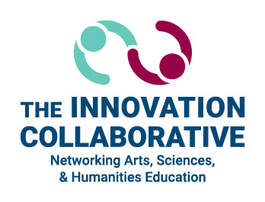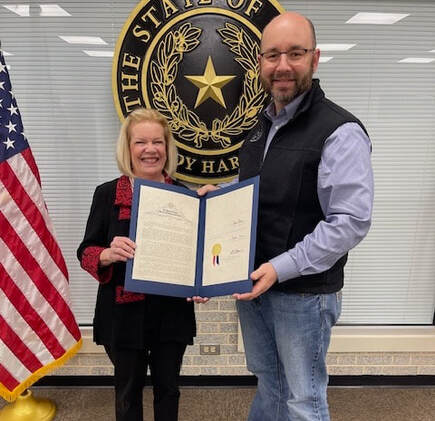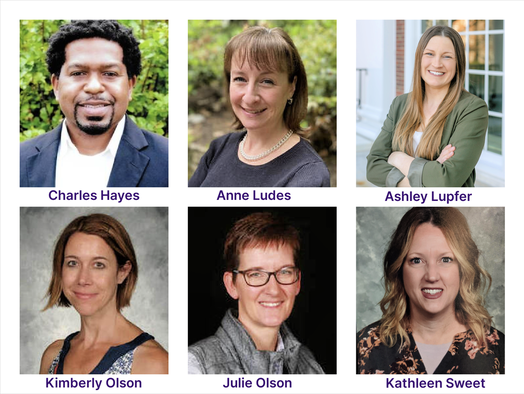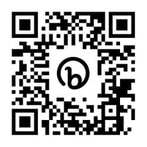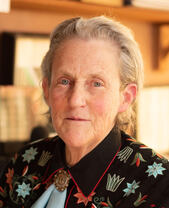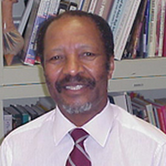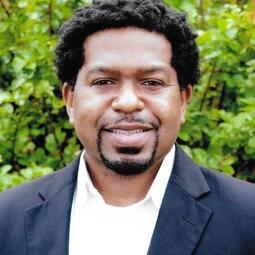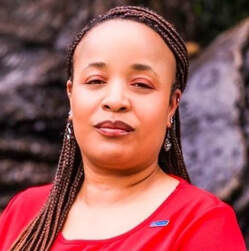 The Innovation Collaborative is launching a subscription campaign for all in- and out-of-school-time educators (preK-16) interested in STEAM education and research-based curriculum resources. The Collaborative, a nonprofit organization, serves as a national forum to foster creativity, innovation, and lifelong learning. It identifies and disseminates information about the many ways that effective integration of the arts, sciences, humanities, engineering, and the use of technology reinforce teaching and incorporate learning in both in-school (formal) and out-of-school-time (informal) settings. This campaign is offering free access to all Innovation Collaborative resources through December 31, 2024, to new subscribers. Click HERE to register. Among the Collaborative’s current web-based resources are:
Beginning in January 2025, there will be a modest annual fee to subscribers. In the coming months, the Innovation Collaborative will be developing and adding new content, including lesson plans, additional rubrics, and professional development programs for both educators and administrators. A virtual STEAM Summit is being planned for fall, 2024. To learn more about the organization’s work, visit www.innovationcollaborative.org.
0 Comments
The importance of failure: |
| Sandra Chapman, PhD, Collaborative Research Thought Leader | Note: Our current series focusing on the importance of failure highlights the Collaborative’s esteemed Research Thought Leaders’ perceptions on this topic. These Thought Leaders are each nationally and internationally known experts in their respective fields. In this article, Sandra Bond Chapman, PhD, points out the importance of embracing failure. Dr. Chapman is Chief Director, Center for BrainHealth, and Dee Wyly Distinguished University Professor, The University of Texas at Dallas. You can find out more about this work at centerforbrainhealth.org; thebrainhealthproject.org. |
“In this year to come, make mistakes, because if you are making mistakes, then you are making new things, trying new things, learning, living, pushing yourself, changing yourself and changing the world.” — Novelist Neil Gaima
The greater the problem, the worse the crisis, the more likely we are to make mistakes. These mistakes can make us more resilient, or they can break us. They can strengthen or weaken our brain’s operating systems.
One of the most perplexing mysteries of our brain is why and how the same event triggers diametrically opposite actions in each of us. When we have no script to follow nor know the best response, our brain veers toward one of these paths after failure—it’s our choice:
As mentors, we have the responsibility to inspire and create a learning context that rewards students, educators, and ourselves to recognize, recover, and rebound from failures with small steps forward. Embracing the risks of failure is the best way to optimize brain growth and development. Without failure, we never tap into the brain’s greatest potential—the ability to generate new ideas and solutions, i.e., to be creative. The faster we recognize failures, the faster we make progress toward our bold goals. The only real failure is when we fail to rescue ourselves from our mistakes. Rescue from failure is one of the most effective thinking strategies to strengthen the brain’s executive function to increase our innovative thinking.
Apollo 13 is a classic example of a situation where “failure is not an option.” Racing against time, NASA engineers devised an ingenious solution to the rupture of an oxygen tank, using only the materials at hand in the spaceship when the astronauts were stranded on their way to the moon in 1970.
We each have the raw talent to kick our brain’s capabilities into gear by regularly acknowledging failed attempts and seeking new and better solutions to improve our work, our relationships, our communities, and the world around us. This is ingenuity. It is a brain skill that is rarely taught and may be the most important brain capacity to optimize the upward potential of brain and cognitive development across the lifespan. The bi-directional benefit of practicing possibility thinking skills in the context of failures not only increases the neural connectivity of the brain’s goal-directed stability network and the updating agility frontal brain network, but it also increases confidence in tackling day-to-day challenges with an open, action-oriented mind, where realizing and embracing failure is the starting point.
(Some content modified from Design Your Brain: 24 Extraordinary Ways to Fuel and Inspire Life, Chapman and Mau, in press)
One of the most perplexing mysteries of our brain is why and how the same event triggers diametrically opposite actions in each of us. When we have no script to follow nor know the best response, our brain veers toward one of these paths after failure—it’s our choice:
- Brain Drain. We experience a humiliating embarrassment, negative and demeaning self-talk that hijacks our thinking or a fear response that paralyzes our actions/behaviors and increases our anxiety and stress. This path acts much like an emergency brake that halts forward progress and keeps us fearful and wallowing in our failures as a stuck mindset.
- Brain Gain. Alternatively, when we openly embrace failure by quickly identifying rather than dismissing mistakes, we build grit. Only then can we adeptly begin to create alternative proactive responses to self-correct. By doing so, we strengthen our brain’s frontal networks—our brain’s CEO that guides clarity and discernment. When we go into problem solving mode to correct mistakes– we override our immobilizing negative self-talk. This ‘embrace the mistake’ path acts like an accelerator to run toward further learning from failures to seek alternate solutions and develop better ways to respond– much like a first responder to a fire.
As mentors, we have the responsibility to inspire and create a learning context that rewards students, educators, and ourselves to recognize, recover, and rebound from failures with small steps forward. Embracing the risks of failure is the best way to optimize brain growth and development. Without failure, we never tap into the brain’s greatest potential—the ability to generate new ideas and solutions, i.e., to be creative. The faster we recognize failures, the faster we make progress toward our bold goals. The only real failure is when we fail to rescue ourselves from our mistakes. Rescue from failure is one of the most effective thinking strategies to strengthen the brain’s executive function to increase our innovative thinking.
Apollo 13 is a classic example of a situation where “failure is not an option.” Racing against time, NASA engineers devised an ingenious solution to the rupture of an oxygen tank, using only the materials at hand in the spaceship when the astronauts were stranded on their way to the moon in 1970.
We each have the raw talent to kick our brain’s capabilities into gear by regularly acknowledging failed attempts and seeking new and better solutions to improve our work, our relationships, our communities, and the world around us. This is ingenuity. It is a brain skill that is rarely taught and may be the most important brain capacity to optimize the upward potential of brain and cognitive development across the lifespan. The bi-directional benefit of practicing possibility thinking skills in the context of failures not only increases the neural connectivity of the brain’s goal-directed stability network and the updating agility frontal brain network, but it also increases confidence in tackling day-to-day challenges with an open, action-oriented mind, where realizing and embracing failure is the starting point.
(Some content modified from Design Your Brain: 24 Extraordinary Ways to Fuel and Inspire Life, Chapman and Mau, in press)
The Collaborative’s Innovation Fellows are top STEAM teachers and administrators who are chosen nationally, based on their excellence in moving the STEAM field forward. Kimberly Olson is the Art Specialist at Centre School in Hampson, NH. Kathleen Sweet is a Computer Science Teacher in Starmont Community School District, IA. Kristin Taylor, EdD, is an Associate Professor of Art Education at California State, Northridge.
collaborative Rubrics Impact Whole Child Learning
| Kimberly Olson | Beyond my ever-evolving STEAM-based learning rooted in problem solving, collaboration, and persistence, I have realized the deep connections, overlaps, and prevalence of culturally responsive and social emotional learning throughout STEAM, the National Visual Arts Standards, and other applicable standards I employ. Through my work as a Teacher Leader with the National Art Education Association’s (NAEA) Connected Arts Network (CAN) I have been able to leverage these connections, developing impactful learning experiences for my students that engage them through their own schema and identity and that develop self and social awareness. |
Most recently, I have been refining a collaborative lesson I co-authored with my CAN colleagues combining student identity and a unit of study based in architecture. (The Innovation Collaborative rubrics have been an invaluable resource in identifying transdisciplinary thinking and learning in this lesson.) Through this unit, students first explore aspects of themselves and their identity (I am…) that cannot be seen physically, such as musical inclinations, interest in sports, dance, baking, theatre, etc. They then apply these aspects to creating a self-reflective building, based on our recent study of a vast (and culturally inclusive) survey of architecture around the world and through time and place. Students envision themselves as a building, plan and sketch their use of architectural elements, materials, colors, and ultimately develop their ideas into a tactile and textural collage. They complete their thinking with a written artist statement which includes explanation and reasoning that prompted each of their I am-inspired choices and where they would want to be built, creating lots of opportunities for synthesis, transformation and bisociation.
Through this lesson students pushed the boundaries of engineering and math in their designed spaces, utilizing shapes and capabilities reflecting aspects of their original I am list. Many of my students serendipitously experimented with dimension in collage constructions, developing three dimensional aspects which added another level of ingenuity, problem-solving, and critical thinking. In response to this emergent aspect of this lesson, I shared the work of Congolese sculptor Bodys Isek Kingelez and Caine’s Arcade as motivation.
Currently, my students are all working to develop mini 3D models of their identity buildings. Their choice, manipulation, and application of materials—as well as design thinking—to demonstrate their original vision has been inspiring to witness! Lots of design thinking, persistence, and revising is happening as students rework their ideas to realize their vision. Reflecting on the success of this lesson has prompted me to access my summer training with Chibitronics and to add a paper circuit element for students that will allow them to illuminate part of their design. Incorporating a broad expanse of the myriad viable overlaps of standards and Thinking Skills has elevated my STEAM-based curriculum to new heights, encompassing the whole child and thinking so important to our 21st-century students.
Through this lesson students pushed the boundaries of engineering and math in their designed spaces, utilizing shapes and capabilities reflecting aspects of their original I am list. Many of my students serendipitously experimented with dimension in collage constructions, developing three dimensional aspects which added another level of ingenuity, problem-solving, and critical thinking. In response to this emergent aspect of this lesson, I shared the work of Congolese sculptor Bodys Isek Kingelez and Caine’s Arcade as motivation.
Currently, my students are all working to develop mini 3D models of their identity buildings. Their choice, manipulation, and application of materials—as well as design thinking—to demonstrate their original vision has been inspiring to witness! Lots of design thinking, persistence, and revising is happening as students rework their ideas to realize their vision. Reflecting on the success of this lesson has prompted me to access my summer training with Chibitronics and to add a paper circuit element for students that will allow them to illuminate part of their design. Incorporating a broad expanse of the myriad viable overlaps of standards and Thinking Skills has elevated my STEAM-based curriculum to new heights, encompassing the whole child and thinking so important to our 21st-century students.
new Makerspace Inspires myriad designs
| I have been teaching for 27 years, 9 years in Colorado and 18 in Iowa. Most of my career has been in K-5 visual arts education, however, in the last two years I have transitioned to a 2nd-5th grade computer science teacher. Since participating as an Innovation Collaborative Fellow, I have received a $30,000 STEM BEST grant and created a Makerspace for my K-12 district. (We converted an old science room into this space. All the furniture is modular and has options for flexible seating.) All students have access to this room and rotate through the Makerspace with a teacher guiding creative and innovative projects, 3D printing, robots, circuits, and many more critical thinking activities. I provided professional development for our district teachers to engage in the Makerspace, so that they would understand the learning that happens when students are in the space. Teachers are now sending whole classrooms to participate. Teachers also come to me for STEAM lesson ideas to incorporate as extensions in their classrooms. Overall, our district is moving forward and embracing STEAM as part of everyday learning. During the recent eclipse, I took my computer science students outside to view the eclipse. Unfortunately, in Iowa, we did not see the totality of it. But I did create a pinhole viewing projector out of a cereal box, as well as having glasses to view with. The students were more interested in the box I made than looking through their glasses. Sometimes simplicity is best. |
Student STEAM Projects: A Visual Tour
| I recently was tasked to teach an innovation and design class. Among other things, I conducted a light painting lesson with students using coding and Sphero, teamed with our music teacher to create Tono scopes that visualize sound, and used Tinkercad to design playgrounds. Sometimes photos explain lessons best—check them out. |
| Our 5th grade students started off the year with a 3D modeling unit designing playground structures for our school. We used the Design Thinking Process, TinkerCad, Augmented Reality, and some top-notch photo editing skills to present our ideas to scale. Our proposals were an exciting way to envision how we could improve our school community while considering elements of design, safety, and overall impact. |
| 5th Grade Innovation and Design students enjoyed learning about autonomous vehicles and the complex programs that enable them to function. We discussed how these vehicles use Artificial Intelligence and asked Chat GPT to program our Sphero for us. We collaboratively analyzed why the JavaScript code did not work and used impressive problem-solving skills to help our robot roll and introduce itself! Next we programmed our Spheros to respond to different lux values, or levels of light created by flashlights in the classroom. Many students programmed them to spin, make sounds, or show an animation on the light matrix. Finally, we discussed the use of GPS, where students plotted different places in our community in the hallway, wrote partner directions, and then programmed our Sphero using these steps! This was challenging but super fun to run their programs with the paper “taxis” students designed. |
book chapter describes kinetic sculpture design
 Kristin Vanderslip Taylor Kristin Vanderslip Taylor I wanted to share that I have a chapter titled "How might we make this work? Using design thinking to engineer kinetic sculptures in the art room" in the newly-published book: STEAM Education: An Interdisciplinary Look at Art in the Curriculum. The chapter is about one of the STEAM visual art lessons that another Collaborative Innovation Fellow, Kerry Buchman, and I shared with the Innovation Collaborative and tested in multiple classrooms. |
 Bonnie Crammond, PhD, Collaborative Research Thought Leader | Bonnie Cramond, PhD, is one of the Collaborative’s highly-respected Research Thought Leaders, who help provide the strong research foundation upon which the Collaborative’s work rests. Dr. Cramond is Professor Emeritus in the University of Georgia Department of Educational Psychology and former Director of the Torrance Center for Creativity and Talent Development. |
Every spring the Torrance Center for Creativity and Talent Development at the University of Georgia hosts a free online festival of ideas related to creativity. The brainchild of Dr. Anna Abraham, the Director of the Torrance Center, this cultural event was envisioned as a way for “creative and innovative professionals across fields of human enterprise (to) present their new exciting projects and innovative ideas to the general public” (2021, Torrance Festival of Ideas pamphlet).
The inaugural festival, held April 23-25, 2021, showcased 21 speakers presenting their expert views on themes relevant to creativity; imagination; visual art; digital art; music; humor; empathy; consciousness; well-being; mindfulness; childhood; aging; education; equality; identity; healing; health; crisis; curiosity; innovation; entrepreneurship; authenticity; political resistance;, and sociocultural change. The festival also highlighted local non-profit organizations in Athens, Georgia that serve the community in creative and crucial ways.
In 2022 and 2023, the global three-day festival again featured speakers on a variety of topics, but in 2022, an invitation was added for people of all ages and backgrounds to submit their creative contributions, which were displayed on the website in the categories of literary, musical, and visual creativity.
This year, the 40th anniversary of the founding of the Torrance Center, the theme was Creativity and Learning. There were 1,000 attendees from several countries around the world and 28 speakers. Scholars and educators steeped in creativity work will recognize many of the speakers and topics which address critical issues and practical implementations in creativity and learning.
Information about the festival, including descriptions of sessions and speakers, as well as links to recorded sessions and other resources, can be found at the Torrance Festival of Ideas website. The pamphlets from each year are linked and contain information about each year’s event. The 2022 pamphlet, which is linked on the festival website, includes the creative products submitted. A selected number of the 2023 talks can be viewed online. The recordings of all the 2024 sessions can be accessed via the festival website where they will remain for a couple of months before they are moved to the UGA College of Education YouTube channel. Links to the talks on YouTube will also be made accessible via the Torrance Festival of Ideas webpage.
Anyone can register for the festival for free, but registrations are limited. So, mark your calendars to look for the Torrance Festival of Ideas next spring. You are sure to learn and be reinvigorated through interaction with imaginative thinkers and creative practitioners as they share their visions and ideas in relatable ways.
The inaugural festival, held April 23-25, 2021, showcased 21 speakers presenting their expert views on themes relevant to creativity; imagination; visual art; digital art; music; humor; empathy; consciousness; well-being; mindfulness; childhood; aging; education; equality; identity; healing; health; crisis; curiosity; innovation; entrepreneurship; authenticity; political resistance;, and sociocultural change. The festival also highlighted local non-profit organizations in Athens, Georgia that serve the community in creative and crucial ways.
In 2022 and 2023, the global three-day festival again featured speakers on a variety of topics, but in 2022, an invitation was added for people of all ages and backgrounds to submit their creative contributions, which were displayed on the website in the categories of literary, musical, and visual creativity.
This year, the 40th anniversary of the founding of the Torrance Center, the theme was Creativity and Learning. There were 1,000 attendees from several countries around the world and 28 speakers. Scholars and educators steeped in creativity work will recognize many of the speakers and topics which address critical issues and practical implementations in creativity and learning.
Information about the festival, including descriptions of sessions and speakers, as well as links to recorded sessions and other resources, can be found at the Torrance Festival of Ideas website. The pamphlets from each year are linked and contain information about each year’s event. The 2022 pamphlet, which is linked on the festival website, includes the creative products submitted. A selected number of the 2023 talks can be viewed online. The recordings of all the 2024 sessions can be accessed via the festival website where they will remain for a couple of months before they are moved to the UGA College of Education YouTube channel. Links to the talks on YouTube will also be made accessible via the Torrance Festival of Ideas webpage.
Anyone can register for the festival for free, but registrations are limited. So, mark your calendars to look for the Torrance Festival of Ideas next spring. You are sure to learn and be reinvigorated through interaction with imaginative thinkers and creative practitioners as they share their visions and ideas in relatable ways.
| Merrie Koester, PhD, Innovation Collaborative Advisory Board Member | Merrie Koester, PhD, Innovation Collaborative Advisory Board member, is the Science Literacy and Communication Specialist at the University of South Carolina Center for Science Education, an Adjunct Professor, College of Charleston School of Education, and Fellow, Near Center for Climate Studies, The Citadel. |
For several years, the dangerous socio-scientific situations created by global warming, sea level rise, and an ever-increasing number of extreme weather events like hurricanes have demanded better community preparedness for such disasters. Students ages 11-18 are often being left out of community-based disaster preparedness programs. Even though there is considerable literature documenting that most preparedness decisions are made with or influenced by others such as family members, friends, coworkers, or neighbors, few of these papers explicitly include youth as important community disaster risk mitigation assets. For the last eight years, as a professional STEAM Teacher Educator, I have been developing and field testing a program called Kids Teaching Flood Resilience (KTFR) in highly flood prone Title 1 schools in Charleston, South Carolina.
In 1996, the National Academies of Sciences, Engineering, and Medicine established the following conceptualization of Scientific Literacy:
Such literacy becomes meaningful knowledge when learners are afforded opportunities to develop and expressively communicate what they know. Arguably, being able to communicate with authority and creative agency is why having science knowledge matters and can save lives.
Towards that end, the work I’ve done in KTFR emphasizes the importance of becoming “Place-Wise” and leans into the fact that our historically marginalized, low-income communities of color disproportionately bear situational flood hazard risks, especially during a hurricane event. Much of this program draws from the powerful work of scholars like urban science educator Christopher Emdin (Urban Science for the Hip Hop Generation: Essential Skills for the Urban Science Educator and Researcher, 2010).
Following Emdin’s lead, throughout the KTFR curriculum, cause and effect relationships have been explored and expressed through poetry and rap. Here some examples of my students’ work:
In 1996, the National Academies of Sciences, Engineering, and Medicine established the following conceptualization of Scientific Literacy:
- Scientific literacy means that a person can ASK, FIND, or DETERMINE answers to questions derived from CURIOSITY about everyday experiences.
- It means that a person has the ability to DESCRIBE, PREDICT, AND EXPLAIN natural phenomena.
Such literacy becomes meaningful knowledge when learners are afforded opportunities to develop and expressively communicate what they know. Arguably, being able to communicate with authority and creative agency is why having science knowledge matters and can save lives.
Towards that end, the work I’ve done in KTFR emphasizes the importance of becoming “Place-Wise” and leans into the fact that our historically marginalized, low-income communities of color disproportionately bear situational flood hazard risks, especially during a hurricane event. Much of this program draws from the powerful work of scholars like urban science educator Christopher Emdin (Urban Science for the Hip Hop Generation: Essential Skills for the Urban Science Educator and Researcher, 2010).
Following Emdin’s lead, throughout the KTFR curriculum, cause and effect relationships have been explored and expressed through poetry and rap. Here some examples of my students’ work:
| What’s The Story in the land? Did a creek once flow where buildings now stand? How does a saltmarsh give and give, creating habitat for animals to live? Fill in a marsh and soon you’ll see, flooding’s a problem for you and me. Water always wins if you tell it NO! Let Water teach us where it needs to go. |
Backstory: Formerly thriving African-American coastal communities have experienced the destruction and paving over of the expansive salt marsh ecosystems that were central to their culture, religion, commerce, recreation, and nutritional sustenance. As a result, these communities have been placed at higher flood risk, even before sea level rise amplified that risk.
The KTFR research claim is as follows: When positioned, empowered, and legitimized as resources of knowledge and action, middle and high school youth have the energy and ability to assess hazardous flooding and extreme weather situations and create messaging for their families that advocates for risk reduction behaviors.
The Get Hurricane Smart curriculum features five domains of Power Knowledge: 1) Get Weather Smart, 2) Place-Wise, 3) Storm Surge Smart, and 4) Water Safe.
The KTFR research claim is as follows: When positioned, empowered, and legitimized as resources of knowledge and action, middle and high school youth have the energy and ability to assess hazardous flooding and extreme weather situations and create messaging for their families that advocates for risk reduction behaviors.
The Get Hurricane Smart curriculum features five domains of Power Knowledge: 1) Get Weather Smart, 2) Place-Wise, 3) Storm Surge Smart, and 4) Water Safe.
| KTFR methods center Place, Problem, and Project Based Learning (PBL). The empowering “STEAM PBL” learning progression is at once active and performative as the artful making of communication artifacts emerges. Full disclosure: We never know what’s going to happen until it does. Inviting uncertainty and vulnerability into the room is also to welcome Art Spirit and its “What if?” kinds of curiosity. Like a developing tropical cyclone system, we constantly look for ways to draw in energy and find steering currents to sustain and aesthetically transform the work. If the effort flops, we try again. When the experience feels like “creative weather”, we know we’re succeeding. |
To date, the KTFR Get Hurricane Smart Toolkit includes a Get Hurricane Smart Rap, a music video, a feature film, Never Say Whatever, Especially in a Hurricane!, a public service announcement, a Kahoot quiz, and a KTFR Sketchbook.
The KTFR program is strongly aligned with the higher order “Creative and Innovative Thinking Skills” described by the Innovation Collaborative. During Flood Resilience Friday sessions, the classroom becomes a performance space, where we make it a point to show the similarities between Art Studio Habits of Mind and the Next Generation Science Standards (NGSS) Science and Engineering Practices:
The KTFR program is strongly aligned with the higher order “Creative and Innovative Thinking Skills” described by the Innovation Collaborative. During Flood Resilience Friday sessions, the classroom becomes a performance space, where we make it a point to show the similarities between Art Studio Habits of Mind and the Next Generation Science Standards (NGSS) Science and Engineering Practices:
The NGSS “Cross Cutting Concepts” take the stage as “characters” in the emerging quest: Whatever “counts” as “hazard risk reduction communication” must be 1) grounded in scientific evidence and 2) show/teach cause and effect relationships, patterns in the data, and/or change over time in ways that make sense. Math matters a lot! All KTFR student “ambassadors” can explain the inverse relationship between Resilience Capacity and Disaster Risk:
In the fall of 2023, in collaboration with the SC Sea Grant Consortium, the Citadel STEM Center, and the Near Center for Climate Studies at the Citadel, we applied for and received a two-year grant from the NOAA National Disaster Preparedness Program so that KTFR might be scaled and sustained in historically underrepresented flood prone coastal communities. Expected deliverables include: A KTFR Field Guide for Teacher Leaders, a series of KTFR & You instructional videos, a board game called Situation, a model for creating your own family-based KTFR event, and a montage film showing what successful KTFR looks like in practice. We have not nearly reached the turning point in this story, and the 2024 Atlantic Hurricane Season promises to be a doozy. Stay tuned.
| Sharon Delesbore, PhD, Innovation Collaborative Board member | The following commentary on the importance of science and how STEAM can enhance it is from a Collaborative Board member, Sharon Delesbore, PhD. Dr. Delesbore is a campus administrator at Stephen F. Austin High School in the Fort Bend Independent School District in Sugar Land, TX. She also serves as President of the Association for Multicultural Science Education (AMSE) and Chair of the Alliance of Affiliates (AoA) of the National Science Teaching Association (NSTA). She has been a science teacher, a science department chair, and a science instructional specialist, and teacher mentor. |
Mahatma Gandhi said, “A nation’s culture resides in the hearts and soul of its people.” This quote resonates resoundingly today as we all work diligently to make our academic institutions stimulating learning environments where students embrace the sciences to become critical thinkers and ecologically productive citizens. More and more, employers are recognizing that their partnership with education is essential in setting the criteria to help produce qualified employees to be productive in the workforce of the future. However, there are several steps the education system needs to take to help this new cadre of students become scientifically literate. Scientific literacy, according to the National Science Teaching Association, “means understanding how science is done, what is science versus non-science, and how to evaluate claims we are exposed to on a daily basis.”
It is my view that school district leaders and campus administrators must realize that science instruction is essential to the sustainability of humankind. Because science understanding is not measured and assessed as frequently as math and reading, it is often underfunded. Thus, the science disciplines’ loss of importance is impacting our workforce, which is suffering from the lack of qualified science-based candidates. Even more dismal is that the science-based candidates from underrepresented populations are a rarity in the global schema. This is not just about ethnicity or low socioeconomic status but now, even more so, access.
What I do see is that teachers who truly appreciate the art of teaching and learning and want to reach all students regardless of race are seeking professional development from organizations to help with their pedagogy. What I do not see is the same influx of campus administrators seeking opportunities to develop their capacity in science education that supports these educators.
As educators and humans in general, we tend to focus and assist in areas where we are strong, confident, and have achieved success. When math or science are discussed, the common comments are, “I was not good at that,” or “Those subjects scare me”. Unfortunately, many adults believe science and math to be difficult subjects and transfer those thoughts to their children at an early age. This then fosters students’ avoidance of science in their school careers. When you couple the negative mental reinforcers with little to poor experiences of science engagement, you are creating a formula for science evasion.
It is time for “Administrators of Advocacy” to step forth in their schools to lead the charge of science for all through STEAM (Science, Technology, Engineering, the Arts, and Math). This initiative can only happen with a change in mindset regarding STEAM implementation, integration, and involvement. STEAM is not just about exposing students to the STEAM disciplines. STEAM enhances important skills in our students when these disciplines are practiced in an integrated manner. These include:
S: Critical thinking in science
T: Engagement offered by experiences with technology
E: Application of what they have learned through engineering practices
A: Integration of arts content and processes to deepen and enrich critical and creative thinking processes in mandated content areas
M: Calculating and processing information in math
These include attributes that are important for every teacher to strive to help their students to acquire. Is this attainable? I believe the answer is yes if campus administrators refrain from hiding from their fears of science education because of their experiences, thoughts, or lack of content knowledge. In truth, good instruction will always prevail.
Specifically, our “Administrators of Advocacy” can do the following:
It is my view that school district leaders and campus administrators must realize that science instruction is essential to the sustainability of humankind. Because science understanding is not measured and assessed as frequently as math and reading, it is often underfunded. Thus, the science disciplines’ loss of importance is impacting our workforce, which is suffering from the lack of qualified science-based candidates. Even more dismal is that the science-based candidates from underrepresented populations are a rarity in the global schema. This is not just about ethnicity or low socioeconomic status but now, even more so, access.
What I do see is that teachers who truly appreciate the art of teaching and learning and want to reach all students regardless of race are seeking professional development from organizations to help with their pedagogy. What I do not see is the same influx of campus administrators seeking opportunities to develop their capacity in science education that supports these educators.
As educators and humans in general, we tend to focus and assist in areas where we are strong, confident, and have achieved success. When math or science are discussed, the common comments are, “I was not good at that,” or “Those subjects scare me”. Unfortunately, many adults believe science and math to be difficult subjects and transfer those thoughts to their children at an early age. This then fosters students’ avoidance of science in their school careers. When you couple the negative mental reinforcers with little to poor experiences of science engagement, you are creating a formula for science evasion.
It is time for “Administrators of Advocacy” to step forth in their schools to lead the charge of science for all through STEAM (Science, Technology, Engineering, the Arts, and Math). This initiative can only happen with a change in mindset regarding STEAM implementation, integration, and involvement. STEAM is not just about exposing students to the STEAM disciplines. STEAM enhances important skills in our students when these disciplines are practiced in an integrated manner. These include:
S: Critical thinking in science
T: Engagement offered by experiences with technology
E: Application of what they have learned through engineering practices
A: Integration of arts content and processes to deepen and enrich critical and creative thinking processes in mandated content areas
M: Calculating and processing information in math
These include attributes that are important for every teacher to strive to help their students to acquire. Is this attainable? I believe the answer is yes if campus administrators refrain from hiding from their fears of science education because of their experiences, thoughts, or lack of content knowledge. In truth, good instruction will always prevail.
Specifically, our “Administrators of Advocacy” can do the following:
- Support teachers with funding for materials and providing appropriate class space for a safe environment to conduct activities.
- Take interest in the science classroom. The constant emphasis on math and reading relays a feeling of insignificance for science and that does not promote a positive school culture. Science is the one discipline that can enhance all the learning skills that administrators are looking for teachers to develop. With emphasis on nonfiction reading, writing, problem solving, and critical thinking with the use of technology to engage students, a focus on science can increase student achievement.
- Empower teachers to take risks in the classroom. This is vital because opportunities “for all” come with exposure. A science-competent mindset is necessary if we want all students to experience science education. There are no boundaries to learning regarding ethnicity, socio-economic status, or gender. All children are curious, and it is up to administrators and teachers to keep the inquiry in their spirits alive.
- Allow teachers to take risks with the curriculum. It is okay if a lesson may not go as planned. Allow for organic exploration that fosters curiosity and creativity.
- Monitor for the expectation of good science instruction. We inspect what we expect and if teachers see that administrators are not looking for hands-on activities or opportunities for inquiry, then they will not present all students with a rigorous curriculum of fundamental science understanding that will help our students excel holistically in academia and in the workforce.
As George Washington Carver stated, “How far you go in life depends on you being tender with the young, compassionate with the aged, sympathetic with the striving and tolerant of the weak and the strong. Because someday in life you will have been all of these.” So, let us maximize our commitment to our educational system so that the overseers of the funding begin to establish opportunities for students to excel in science education, once and “for all.”
US representatives draw support for STEAM programs at hbcus
 Democratic Minority Leader Hakeem Jeffries (D-NY) and Rep. Alma Adams (D-NC) attend the Seventh Annual STEAM Days of Action in April.
Democratic Minority Leader Hakeem Jeffries (D-NY) and Rep. Alma Adams (D-NC) attend the Seventh Annual STEAM Days of Action in April. Democratic Rep. Alma Adams (D-NC) recently engaged lawmakers on Capitol Hill to support STEAM programs in HBCUs (Historically Black Colleges and Universities). Adams, who is founder of the congressional HBCU Caucus, hosted the Seventh Annual STEAM Days of Action with Congressman French Hill (R-AR) in April.
In a recent article in the Washington Informer, Rep. Adams spoke about the significance of supporting STEAM programs in HBCUs.
“HBCUs produce over a quarter of African American STEM/STEAM graduates in the United States, and it has never been more important to make sure every talented student has access to a world-class science, technology, engineering, arts, and math education,” Adams said.
The conference featured discussions with Janet McCabe, Deputy Administrator of the Environmental Protection Agency, and Cindy Marten, Deputy Secretary of the US Department of Education. https://www.washingtoninformer.com/hbcu-stem-education-investment/
In a recent article in the Washington Informer, Rep. Adams spoke about the significance of supporting STEAM programs in HBCUs.
“HBCUs produce over a quarter of African American STEM/STEAM graduates in the United States, and it has never been more important to make sure every talented student has access to a world-class science, technology, engineering, arts, and math education,” Adams said.
The conference featured discussions with Janet McCabe, Deputy Administrator of the Environmental Protection Agency, and Cindy Marten, Deputy Secretary of the US Department of Education. https://www.washingtoninformer.com/hbcu-stem-education-investment/
Syracuse Museum Announces $3 Million Earmarked for STEAM Renovation Project

Senate Majority Leader Chuck Schumer (D-NY)and US Senator Kirsten Gillibrand (D-NY) and US Representative Brandon Williams (R-NY) recently secured $3 million for renovating the south wing of the MOST Museum in Syracuse.
Formerly the New York State Armory built in 1907, the building now houses the Milton J. Rubenstein Museum of Science & Technology. The project supports science and art education for future employees of Micron, a microchip processing manufacturer planning to relocate to central New York.
“From Micron’s major investment in Central NY to the exciting research going on at SU [Syracuse University], places like the MOST that combine learning and fun are how we can spark interest early on for the STEAM jobs that will be building Syracuse’s future,” Sen. Schumer stated on UrbanCNY. https://bit.ly/3Wn3oJ4
Formerly the New York State Armory built in 1907, the building now houses the Milton J. Rubenstein Museum of Science & Technology. The project supports science and art education for future employees of Micron, a microchip processing manufacturer planning to relocate to central New York.
“From Micron’s major investment in Central NY to the exciting research going on at SU [Syracuse University], places like the MOST that combine learning and fun are how we can spark interest early on for the STEAM jobs that will be building Syracuse’s future,” Sen. Schumer stated on UrbanCNY. https://bit.ly/3Wn3oJ4
100 Black Girls STEAM! introduces Certification program
| Photo by Christina @ wocintechchat.com on Unsplash | This San Diego-based project aims to provide an Informal STEAM Learning Certification for 100 Black girls in middle and high school in California area and across the country, with the goal of introducing them to a variety of career choices and role models in science, technology, engineering, arts, and mathematics. The in-person & virtual #RemakeDays learning events launched on April 20 and formally concludes on May 31 but can still be accessed HERE. |
Crayola launches Campaign for Creativity

For the past year Crayola researchers and educators have worked with the National Ad Council, the renowned organization that specializes in messaging campaigns that shift public perceptions and increase intentional actions, and the creativity scholar Dr. Gerard Puccio, in studying current perceptions of creativity and ways to motivate parents to create more creative moments with their children. Dr. Gerard Puccio has more than 30 years of experience as both a thought leader in the field of creativity and as a creativity researcher. Dr. Gerard Puccio, a State University of New York Distinguished Professor and chair of the Center for Applied Imagination at Buffalo State University, shared his vast knowledge of the field to verify the content validity of the Crayola Campaign for Creativity. Dr. Puccio conducted a comprehensive literature review of contemporary creativity research to inform several new studies that Crayola and the Ad Council conducted to document what parents think about the role of creativity in shaping children’s future.
Highlights from their work include a set of interesting challenges that creativity advocates face. While parents believe creativity is important, more than half say they don’t have the creative skills or confidence to help develop creativity in their children. Good news is that:
Yet the majority of parents say, “people outgrown their creative mindsets as they age beyond childhood”; “creativity is something a few lucky individuals are born with and most people lack”; and “creative experiences as a child will only help kids develop skills they need for jobs in the arts, fashion, or design” — without the acknowledgement that creativity is an essential life skill that can be taught, must be nurtured, and leads to success in any career.
To increase parents understanding of creativity and provide them with inspiration to create more creative moments, Crayola launched the campaign to help everyone #StayCreative.
To learn more, visit https://www.crayola.com/featured/campaign-for-creativity
Highlights from their work include a set of interesting challenges that creativity advocates face. While parents believe creativity is important, more than half say they don’t have the creative skills or confidence to help develop creativity in their children. Good news is that:
- 96% of parents believe that creativity is important to society.
- 92% of parents believe creativity has life-long benefits for their kids.
- 87% of parents believe creative thinking is critical to problem solving and career success.
- 78% of employees say creativity is important to their current career.
Yet the majority of parents say, “people outgrown their creative mindsets as they age beyond childhood”; “creativity is something a few lucky individuals are born with and most people lack”; and “creative experiences as a child will only help kids develop skills they need for jobs in the arts, fashion, or design” — without the acknowledgement that creativity is an essential life skill that can be taught, must be nurtured, and leads to success in any career.
To increase parents understanding of creativity and provide them with inspiration to create more creative moments, Crayola launched the campaign to help everyone #StayCreative.
To learn more, visit https://www.crayola.com/featured/campaign-for-creativity
Collaboration Offers STEAM Activities to Students in Underserved Urban Community

A new collaboration between the Citizens Science Lab and the Young Black Motivated Kings and Queens (YBMKQ) is bringing STEAM education to kids in an underserved Pittsburgh community known as Penn Hills. YBMKQ offers low-cost afterschool and summer activities to roughly 60 elementary, middle, and high school students in the town’s community center.
The story was reported in Kidsburgh, a news outlet focusing on youth news and activities. Dr. Andre Samuel, founder of the Citizens Science Lab, told Kidsburgh why the five-year partnership is significant.
“Nationally, only less than 5% of PhD’s handed out in the biological and life sciences are held by African Americans,” he said. “And so it’s important for us to get out there, create more Black scientists so that we can address more issues that deal with our communities.” https://www.kidsburgh.org/partnership-brings-steam-education-to-penn-hills/
The story was reported in Kidsburgh, a news outlet focusing on youth news and activities. Dr. Andre Samuel, founder of the Citizens Science Lab, told Kidsburgh why the five-year partnership is significant.
“Nationally, only less than 5% of PhD’s handed out in the biological and life sciences are held by African Americans,” he said. “And so it’s important for us to get out there, create more Black scientists so that we can address more issues that deal with our communities.” https://www.kidsburgh.org/partnership-brings-steam-education-to-penn-hills/
MIT Sponsors steam challenge for sustainable living

The Village School of Houston and MIT are partnering in a "Build Better: Plants, Energy, Everything" STEAM challenge that inspires solutions for sustainable living. Primary and secondary students are brainstorming ways to develop a more sustainable future with less environmental impact. The challenge leads students to collectively explore sustainability in production of food, energy, and manufacturing of everyday objects.
The Houston school belongs to Nord Anglia Education of London, which has international schools with more than 80,000 students.
Luke Thurston, communications director for the Village School, told the journal Digital Engineering that MIT sponsors the annual competition for Nord Anglia students around the world.
“[Students] use active research to meet each challenge so they get thinking about creative solutions to problems,” Thurston said. “[They] will take part in the challenges to tackle some of the most pressing issues facing the world today.” https://bit.ly/3wTH0fR
The Houston school belongs to Nord Anglia Education of London, which has international schools with more than 80,000 students.
Luke Thurston, communications director for the Village School, told the journal Digital Engineering that MIT sponsors the annual competition for Nord Anglia students around the world.
“[Students] use active research to meet each challenge so they get thinking about creative solutions to problems,” Thurston said. “[They] will take part in the challenges to tackle some of the most pressing issues facing the world today.” https://bit.ly/3wTH0fR
wallace foundation measures data collection in out-of-school programs

A recent study by the Wallace Foundation reveals how out-of-school programs measure and collect data, especially regarding equity. The New York City-based foundation analyzed obstacles to data collection, as well as how to remove them.
One key finding was that programs measured outcomes that reflected their content, which ranged from arts, to workforce readiness, to civic engagement, to social emotional outcomes. https://bit.ly/48z70dF
One key finding was that programs measured outcomes that reflected their content, which ranged from arts, to workforce readiness, to civic engagement, to social emotional outcomes. https://bit.ly/48z70dF

Creating Equity for Black Science Students
Creating equity for Black science students requires deep listening and can be achieved with phenomenological qualitative research and a community of inquiry. This phenomenological study examines the lived experience of a phenomenon by a student. The article investigates how Black students perceive advanced science classes and what prevents them from enrolling. To create equity, a community of inquiry consisting of educators analyzed the student perceptions of advanced courses, identified barriers, and then proposed solutions to reduce or remove obstacles. Research methods, student data, and study results are discussed. Suggestions for readers applying the author's plan are also provided. READ MORE.
Becoming Botanical Garden Educators: Using Flip to Engage High School Students in Botany
It is critical to develop students’ science communication skills as they progress through their education. One way this goal can be accomplished is by integrating Flip cameras into educational programs. Through Flip educators create prompts that students respond to in video form, which leads to deeper discussion on various topics. This brief will share an example of how Flip was used with high school students spending time at a botanical garden to not only promote science communication skills but also to help engage them with plant life. In this activity students assume the role of “educator” by becoming an expert on a specific plant species and recording a video introducing others to that organism. READ MORE.
Co-Development of a Museum-Based Scientist-Teacher Partnership
Scientist-led K–12 outreach offers many benefits to scientists, teachers, and students; however, many of these programs are top-down rather than collaborative. This team facilitated a museum-based scientist-teacher partnership to co-design a lesson on shark biology for middle school students. Following the implementation of the lesson, they conducted interviews with the scientist and teacher participants. The participants described several benefits for the students including contextualizing science in the real world, providing exposure to new careers, and humanizing scientists. Teacher benefits included increased content knowledge and feeling reenergized to teach their subject. The scientists gained knowledge about science standards and classroom pedagogy. The challenges to the partnership included time constraints and restrictions enforced by the school districts. Using the findings from the study, they describe how other organizations can facilitate similar scientist-teacher partnerships to help improve science literacy and career aspirations. Scientist-teacher partnerships are highly effective for improving scientists’ communication skills, increasing teachers’ content knowledge, and contextualizing science for students. READ MORE.
Creating equity for Black science students requires deep listening and can be achieved with phenomenological qualitative research and a community of inquiry. This phenomenological study examines the lived experience of a phenomenon by a student. The article investigates how Black students perceive advanced science classes and what prevents them from enrolling. To create equity, a community of inquiry consisting of educators analyzed the student perceptions of advanced courses, identified barriers, and then proposed solutions to reduce or remove obstacles. Research methods, student data, and study results are discussed. Suggestions for readers applying the author's plan are also provided. READ MORE.
Becoming Botanical Garden Educators: Using Flip to Engage High School Students in Botany
It is critical to develop students’ science communication skills as they progress through their education. One way this goal can be accomplished is by integrating Flip cameras into educational programs. Through Flip educators create prompts that students respond to in video form, which leads to deeper discussion on various topics. This brief will share an example of how Flip was used with high school students spending time at a botanical garden to not only promote science communication skills but also to help engage them with plant life. In this activity students assume the role of “educator” by becoming an expert on a specific plant species and recording a video introducing others to that organism. READ MORE.
Co-Development of a Museum-Based Scientist-Teacher Partnership
Scientist-led K–12 outreach offers many benefits to scientists, teachers, and students; however, many of these programs are top-down rather than collaborative. This team facilitated a museum-based scientist-teacher partnership to co-design a lesson on shark biology for middle school students. Following the implementation of the lesson, they conducted interviews with the scientist and teacher participants. The participants described several benefits for the students including contextualizing science in the real world, providing exposure to new careers, and humanizing scientists. Teacher benefits included increased content knowledge and feeling reenergized to teach their subject. The scientists gained knowledge about science standards and classroom pedagogy. The challenges to the partnership included time constraints and restrictions enforced by the school districts. Using the findings from the study, they describe how other organizations can facilitate similar scientist-teacher partnerships to help improve science literacy and career aspirations. Scientist-teacher partnerships are highly effective for improving scientists’ communication skills, increasing teachers’ content knowledge, and contextualizing science for students. READ MORE.

As STEAM (Science, Technology, Engineering, the Arts/Humanities, and Math) continues to grow rapidly in the Informal Science Learning (ISL) Out-of-School-Time field, there exists a wide variety of STEAM findings from both researchers and practitioners. These findings are often developed in silos – research isolated from practice and practice from research. The Collaborative, in an initial informal study of this phenomenon, found that there was broad interest from both researchers and practitioners in bridging this gap, especially relating to equity in ISL. They demonstrated significant interest in developing ways to be aware of each other’s work and potentially to collaborate.
To address this, Texas Southern University (TSU), one of the largest and most comprehensive HBCU’s (Historically Black Colleges and Universities) in the U.S., graciously partnered with the Collaborative. TSU, a long-time member of the Collaborative, is represented on the Collaborative Board of Directors by Bernnell Peltier-Glaze, Ed.D., Associate Professor, and on the Advisory Council by Lillian Poats, Ed.D., Professor and Former Acting Provost & Vice President for Academic Affairs & Research. Both are members of TSU’s Department of Educational Administration and Foundations in the College of Education.
Dr. Peltier-Glaze, Dr. Poats, and Collaborative Executive Director Lucinda Presley developed this successful grant proposal. Dr. Poats is now the grant’s Principal Investigator (PI); Dr. Peltier-Glaze and Lucinda Presly are the Co-PIs. They are joined on the grant’s Leadership Team by Grant Advisor Judy Koke, Deputy Director and Director of Professional Learning at Institute for Learning Innovation, and by Grant Evaluator Kathy Terry, Senior Researcher at American Institutes for Research.
This grant is a two-year (2023-2025) STEAM ISL working conference project that integrates a two-day in-person conference with two years’ virtual work by all participants. It addresses: 1) the need to develop more mutually supportive links between researchers and practitioners; 2) equitable access, framing, and design in STEAM ISL; and (3) through STEAM ISL, engaging underserved populations in STEM.
The project accomplishes this by developing a cohesive approach, integrating research and practice to the most salient topics regarding equity, well-being, and belonging in STEAM ISL, with particular attention to where is the field now and the critical next steps that need to be taken. The project is also creating an effective model for a STEAM ISL working conference project to address equity, well-being, and belonging.
Project participants will immerse themselves throughout these two years in equity, well-being, and belonging, choose and frame the seven most important topics to address, and investigate them through virtual and in-person convenings.
The chosen topics are the result of a comprehensive literature review, surveys of the researcher/practitioner primary participants, and grant Advisory Council input. The topics, each of which are represented by an investigating cohort, are:
To investigate these topics in cohorts, 23 participants—leading researchers and practitioners from across the US who were part of the project development--will attend the In-person conference July 25-26 in Houston, TX, and work virtually with their cohort throughout this two-year project. Approximately another 50 participants will work with their cohort virtually the entire two-year period. Approximately 75 polled participants will complete several surveys about the topics throughout this project.
The findings will then be consolidated and communicated to very broad and diverse audiences. The anticipated outcome of this project is a more cohesive view of STEAM ISL field is in relation to equity that will benefit a broad spectrum of underserved populations.
To address this, Texas Southern University (TSU), one of the largest and most comprehensive HBCU’s (Historically Black Colleges and Universities) in the U.S., graciously partnered with the Collaborative. TSU, a long-time member of the Collaborative, is represented on the Collaborative Board of Directors by Bernnell Peltier-Glaze, Ed.D., Associate Professor, and on the Advisory Council by Lillian Poats, Ed.D., Professor and Former Acting Provost & Vice President for Academic Affairs & Research. Both are members of TSU’s Department of Educational Administration and Foundations in the College of Education.
Dr. Peltier-Glaze, Dr. Poats, and Collaborative Executive Director Lucinda Presley developed this successful grant proposal. Dr. Poats is now the grant’s Principal Investigator (PI); Dr. Peltier-Glaze and Lucinda Presly are the Co-PIs. They are joined on the grant’s Leadership Team by Grant Advisor Judy Koke, Deputy Director and Director of Professional Learning at Institute for Learning Innovation, and by Grant Evaluator Kathy Terry, Senior Researcher at American Institutes for Research.
This grant is a two-year (2023-2025) STEAM ISL working conference project that integrates a two-day in-person conference with two years’ virtual work by all participants. It addresses: 1) the need to develop more mutually supportive links between researchers and practitioners; 2) equitable access, framing, and design in STEAM ISL; and (3) through STEAM ISL, engaging underserved populations in STEM.
The project accomplishes this by developing a cohesive approach, integrating research and practice to the most salient topics regarding equity, well-being, and belonging in STEAM ISL, with particular attention to where is the field now and the critical next steps that need to be taken. The project is also creating an effective model for a STEAM ISL working conference project to address equity, well-being, and belonging.
Project participants will immerse themselves throughout these two years in equity, well-being, and belonging, choose and frame the seven most important topics to address, and investigate them through virtual and in-person convenings.
The chosen topics are the result of a comprehensive literature review, surveys of the researcher/practitioner primary participants, and grant Advisory Council input. The topics, each of which are represented by an investigating cohort, are:
- equity;
- well-being;
- belonging and identity;
- increasing professional capacity for informal educators;
- intersections of formal (K-12) and informal (Out-of-School-Time) learning;
- integrating the arts with STEM to promote STEM engagement, learning, and thinking;
- STEAM creative/innovative thinking and equity.
To investigate these topics in cohorts, 23 participants—leading researchers and practitioners from across the US who were part of the project development--will attend the In-person conference July 25-26 in Houston, TX, and work virtually with their cohort throughout this two-year project. Approximately another 50 participants will work with their cohort virtually the entire two-year period. Approximately 75 polled participants will complete several surveys about the topics throughout this project.
The findings will then be consolidated and communicated to very broad and diverse audiences. The anticipated outcome of this project is a more cohesive view of STEAM ISL field is in relation to equity that will benefit a broad spectrum of underserved populations.
The Collaborative was recognized by the 88th Texas Legislature for its 10-year anniversary. The recognition was made possible by Cody Harris, Texas State Representative from District 8, in which the Collaborative is legally based.
The resolution noted the Collaborative’s contribution to education throughout the US. This contribution, it notes, applies its research-based focus on creativity and innovation through the intersections of Science, Technology, Engineering, the Arts/Humanities, and Math (STEAM) in K-12 and lifelong learning.
The resolution noted the Collaborative’s contribution to education throughout the US. This contribution, it notes, applies its research-based focus on creativity and innovation through the intersections of Science, Technology, Engineering, the Arts/Humanities, and Math (STEAM) in K-12 and lifelong learning.
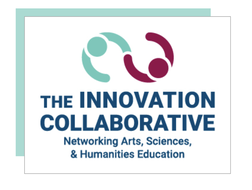
The non-profit STEAM education organization, the Innovation Collaborative, has been awarded an anonymous $120,000 grant to build its infrastructure and expand its reach and visibility to education stakeholders throughout the country. The Collaborative provides information about how effective intersections of the STEAM subject areas—Sciences, Technology, Engineering, Arts/Humanities and Math—can reinforce creative and innovative thinking in K-12 and out of-school-time.
STEAM is an approach to education that promotes student-led explorations driven by curiosity and the application of competencies and practices across academic disciplines that can effectively and equitably prepare them for success in education and the 21st century workforce.
Now in its eleventh year, the Innovation Collaborative previously had been awarded multiple grants, including from the National Endowment for the Arts, to help them fulfill their mission of conducting and sharing STEAM-based research on teacher professional development and classroom practice across the recognized well-rounded subject areas.
According to Executive Director Lucinda Presley, the new grant will enable the Collaborative to substantially expand its efforts to promote the value and purpose of STEAM education to a broader national audience. “I truly believe this award will help us reach decision-makers, educators, and parents who are interested in STEAM education but don’t necessarily understand how it can be effectively integrated into the curriculum of their schools’ and students’ daily learning.”
The Collaborative’s Strategic Advisor Jonathan Katz, former Chief Executive Officer for the National Assembly of State Arts Agencies, pointed out that the organization has done a substantial amount of important work supporting rigorous STEAM focused research and identifying exemplary practices in the field. “The challenge,” he added, “is getting the word out to teachers and their leadership that we have resources to do this sort of teaching intentionally—that is, to bring the STEAM subject areas together in terms of instruction and evaluation and improve student learning in a holistic way that is both meaningful and valuable to their overall education.”
Presley said the anonymous grant funds will be strategically applied over a three-year period and used to support a part-time staff that will be working to refresh the Collaborative’s website, raise its profile through social media and its newsletter, and establish opportunities for scholars and K-12 educators to propose STEAM-based new research and lessons that can be shared by the organization.
For more information about the Innovation Collaborative visit https://www.innovationcollaborative.org/ and follow us on Facebook @innovationcollaborative.org, on X at #innovationcollaborative & LinkedIn at https://www.linkedin.com/company/innov-collab/
STEAM is an approach to education that promotes student-led explorations driven by curiosity and the application of competencies and practices across academic disciplines that can effectively and equitably prepare them for success in education and the 21st century workforce.
Now in its eleventh year, the Innovation Collaborative previously had been awarded multiple grants, including from the National Endowment for the Arts, to help them fulfill their mission of conducting and sharing STEAM-based research on teacher professional development and classroom practice across the recognized well-rounded subject areas.
According to Executive Director Lucinda Presley, the new grant will enable the Collaborative to substantially expand its efforts to promote the value and purpose of STEAM education to a broader national audience. “I truly believe this award will help us reach decision-makers, educators, and parents who are interested in STEAM education but don’t necessarily understand how it can be effectively integrated into the curriculum of their schools’ and students’ daily learning.”
The Collaborative’s Strategic Advisor Jonathan Katz, former Chief Executive Officer for the National Assembly of State Arts Agencies, pointed out that the organization has done a substantial amount of important work supporting rigorous STEAM focused research and identifying exemplary practices in the field. “The challenge,” he added, “is getting the word out to teachers and their leadership that we have resources to do this sort of teaching intentionally—that is, to bring the STEAM subject areas together in terms of instruction and evaluation and improve student learning in a holistic way that is both meaningful and valuable to their overall education.”
Presley said the anonymous grant funds will be strategically applied over a three-year period and used to support a part-time staff that will be working to refresh the Collaborative’s website, raise its profile through social media and its newsletter, and establish opportunities for scholars and K-12 educators to propose STEAM-based new research and lessons that can be shared by the organization.
For more information about the Innovation Collaborative visit https://www.innovationcollaborative.org/ and follow us on Facebook @innovationcollaborative.org, on X at #innovationcollaborative & LinkedIn at https://www.linkedin.com/company/innov-collab/
The Importance of Failure
| Bob Root-Bernstein, PhD, Collaborative Research Thought Leader Note: Well-known STEAM expert, Bob Root-Bernstein, PhD, responded to the Collaborative’s request for his perception of the importance of failure. Dr. Root-Bernstein is a MacArthur Fellow and Professor Emeritus of Physiology, Michigan State University. In addition to his research on auto-immune diseases, Dr. Root-Bernstein is known for his research into STEAM and creativity. | The Only Failure Is Not to Try Fear of failure is one of the greatest obstacles to developing the skills required to master any endeavor, creative or otherwise. Example: When I was in college, I and a friend went downhill skiing for the first time. As soon as I’d mastered a basic snowplow position, I immediately started experimenting with keeping my skis parallel. I fell – I fell a LOT! But by the second day, I was on the intermediate slopes trying to get through the moguls. I fell even MORE. In fact, I was black and blue on both sides of my body from hitting the hard-packed snow so many times. But I managed to get down the intermediate slope without falling by the end of the second day. Trudging painfully back to the lodge, I met my friend who proudly announced that he hadn’t fallen even once! But he was still doing snowplows on the bunny slope. I was reminded of my skiing experience some years later when I was trying to mentor a student in the lab who was supposedly the smartest high school student in all of San Diego County. He wanted to become a creative scientist. His first assignment was the same one that I had been given when I was hired, which was a somewhat intricate series of procedures that literally no one in the entire history of the lab had ever managed to do right the first time. All of us had tried to figure out what made the procedure so finicky, without success. And all of us, after several – sometimes MANY – tries, had managed to make it work. We figured that doing the procedure was like learning to play a new musical instrument: there were patterns to learn, skills to master, and matters of timing that could only be acquired through trial-and-error before everything “clicked.” I explained all of this to the high school student, and he confidently started the experiment. It failed, no surprise. I told him to try again the next day; it would go better. He refused. “I’ve never failed at anything!,” he exclaimed and never returned. One final story, which is that of Michael Jordan, certainly one of the best and most innovative basketball players ever. When asked what his secret was, he said that unlike most of his fellow players, who honed the skills they were already best at, he focused exclusively on mastering the things he at which he was worst. Failure isn’t being unable to do something: failure is refusing to keep trying to get better at the things you can’t do! What Is Failure? Failure is not part of my vocabulary. To try something, no matter the outcome, is to learn. Let me give you an example. Many years ago, I got interested in M.C. Escher’s designs, particularly those that involve what are known as “tilings.” Tilings involve shapes, usually geometrical ones, that can cover a surface without leaving any gaps. A checkerboard is a good example, in which 64 red and black squares entirely cover a square-shaped surface. Escher became famous for morphing regular geometrical shapes into animals and people and other fantastic things. After gathering up my courage, I decided to see if I could design Escher-like tilings, too. Some of my efforts succeeded, some didn’t, but the “failures” were actually more useful for teaching me what the “rules’ are for this kind of artwork than were the successes. Simply put, when you succeed at something, you don’t learn anything new but when you don’t, you have to figure out why in order to improve your performance. After a few years, I got bored. Doing something that Escher had already done better wasn’t very exciting. Then I learned about another artist-scientist named Roger Penrose who had taken a similar trajectory as mine, first learning how to mimic Escher tilings and then inventing an entirely new type of tilings that no one had ever imaged before. These “Penrose tilings” are made up of two odd shapes that cover a surface completely but do so in such a way that the pattern never repeats. They are called “aperiodic tilings.” Very cool! Reading about Penrose tilings, I then learned that there was a yet another tiling challenge that no one had succeeded in solving, which was to discover the “ein stein.” This ein stein has nothing to do with Albert Einstein; it is German for “one stone” or, in this case, a single tile that, like the Penrose tiles, covers a surface aperiodically. Now THAT sounded like something that could be fun to try my hand at! I spent a couple of years trying to discover the ein stein and, at one point, I thought I’d discovered it! However, a few weeks later, I was able to demonstrate that my tile wasn’t truly THE ein stein, just something close. I kept at it. Then, a few months ago, another amateur ein stein hunter succeeded where I hadn’t. Had I “failed”? Not at all! When I looked at this other guy’s solution, I was immediately able to see what he’d done that I hadn’t and to appreciate, as I could not possibly have done otherwise, how clever he had been. And I had learned an enormous amount about an area of geometry that I would never have had a clue about had not decided to pursue the ein stein. I don’t see how this can be considered a failure! By the way, Penrose also “failed” to find the ein stein – but he did win a Nobel Prize in Physics a few years ago! |
'Scientific American' features poem by Collaborative Strategic Advisor
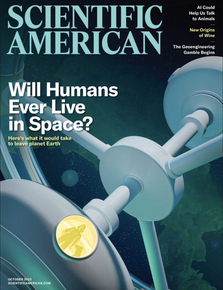
The October 2023 issue of Scientific American (Vol. 329, No. 3) features a poem by Innovation Collaborative board member and Strategic Advisor Jonathan Katz.
Says Katz, “Poetry is a great medium for exploring the mysteries and ambiguities of human existence. As artificial intelligence enables large data bases, algorithms and bots to approach human senses of consciousness and individuality, a lot of fertile ground for poems emerges. AI propels both a perception of competition and a sense of solidarity between flesh-based and digital entities. Will bots enjoy poems? That remains to be seen, but a knee-jerk “no” in response to that question demonstrates the kind of hubris that gets humans in trouble. I find writing for an audience that includes digital entities a pretty interesting process and I think others who try it will find that as well.” C&R Press has published three collections of Katz’s poetry: Love Undefined, Objects in Motion, and Lottery of Intimacies. Click HERE to read the poem in Scientific American.
Says Katz, “Poetry is a great medium for exploring the mysteries and ambiguities of human existence. As artificial intelligence enables large data bases, algorithms and bots to approach human senses of consciousness and individuality, a lot of fertile ground for poems emerges. AI propels both a perception of competition and a sense of solidarity between flesh-based and digital entities. Will bots enjoy poems? That remains to be seen, but a knee-jerk “no” in response to that question demonstrates the kind of hubris that gets humans in trouble. I find writing for an audience that includes digital entities a pretty interesting process and I think others who try it will find that as well.” C&R Press has published three collections of Katz’s poetry: Love Undefined, Objects in Motion, and Lottery of Intimacies. Click HERE to read the poem in Scientific American.
NEUROSCIENCE: STRENGTHENING YOUR BRAIN
 Sandi Chapman, PhD
Sandi Chapman, PhD Collaborative Research Thought Leader Sandi Chapman, PhD, and her institution, the UT Dallas Center for BrainHealth, invite you to participate in their Great Brain Gain challenge. You can access this challenge in their invitation below. Enjoy seeing how you can strengthen your brain.
Our brain is one of the most modifiable parts of our body. Like our muscles, the brain can be strengthened over time. While many people know their brain can improve, they often don’t know what they can or should do to take action. Instead of focusing on decline, disease and doubt, Center for Brain Health is helping people everywhere feel empowered to improve and strengthen their brains’ fitness through daily, science-backed habits that make a difference.
A simple first step to do this is to join the Center for BrainHealth’s 7-day Great Brain Gain text challenge, by texting GAIN to 888-844-8991. You’ll get daily tips to build brain-healthy habits in your everyday life. Here are 3 examples:
- Practice reframing a situation when things don’t go as planned;
- Take a new approach to to-do lists by dedicating your brain’s prime time (when you’re most fresh) to tasks that require deeper thinking;
- Consider different viewpoints to increase your flexible thinking.
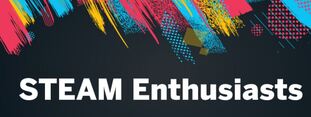
STEAM enthusiasts community
The American Association for the Advancement of Science's (AAAS) discussion board for All Things STEAM (users must create a login to access the discussions) http://tinyurl.com/ykfjkmsn
Progressive science education curriculum
This book chapter abstract by Merrie Koester and Meta Van Sickle outlines how necessary the arts are for the fullest expression of any kind of learning, including and especially science. http://tinyurl.com/z82cesmf
The American Association for the Advancement of Science's (AAAS) discussion board for All Things STEAM (users must create a login to access the discussions) http://tinyurl.com/ykfjkmsn
Progressive science education curriculum
This book chapter abstract by Merrie Koester and Meta Van Sickle outlines how necessary the arts are for the fullest expression of any kind of learning, including and especially science. http://tinyurl.com/z82cesmf
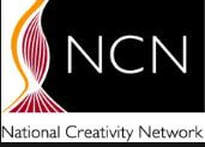
The National Creativity Network
The National Creativity Network engages, connects, informs, promotes, and counsels cross-sector stakeholders who skillfully use imagination, creativity, and innovation to foster vibrant and flourishing individuals, institutions, and communities across North America. Find out more on how to get involved and check out the article links on their blog. https://nationalcreativitynetwork.org/
The National Creativity Network engages, connects, informs, promotes, and counsels cross-sector stakeholders who skillfully use imagination, creativity, and innovation to foster vibrant and flourishing individuals, institutions, and communities across North America. Find out more on how to get involved and check out the article links on their blog. https://nationalcreativitynetwork.org/
Connecting STEAM to agriculture
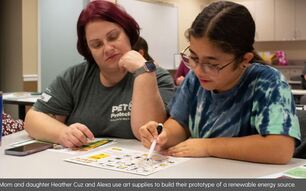
A University of Delaware program is equipping Delaware 4-H students with science, technology, engineering, arts, and math (STEAM) skills, and connecting them to agriculture.
Twila Parish-Short, a 4-H youth development science educator with UD Cooperative Extension, is incorporating those five disciplines into educational programming and activities for children and teenagers around the state. She is developing a team of teenage ambassadors, as she calls them, to lead youth in STEAM education and activities. The hope, Parish-Short said, is for those ambassadors to bring the activities back to their communities, help young people explore their interest in STEAM fields, and broaden 4-H’s reach.
“I’m envisioning these young STEAM ambassadors building their confidence to get into STEAM careers,” Parish-Short said. She recently hosted an event in for her first STEAM Team. Students formed groups to work on activities for this year’s 4-H STEM Challenge from the National 4-H Council. They were given projects on renewable energy that prompted them to choose an energy source to power a fictional bunker. Then, they built prototypes for those renewable energy sources using arts and crafts materials provided by Parish-Short. Read the full article HERE.
Building science and engineering skills through STEAM
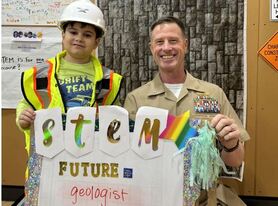
The U.S. NAVFAC Northwest facility in Bothell, Washington, launched its Science, Technology, Engineering, and Mathematics (STEM) program, with an inaugural “Once Upon a STEAM” fairytale-themed Science, Technology, Engineering, Art, and Math (STEAM) community event held at Woodside Elementary School this past November.
Volunteers from NAVFAC Northwest joined a diverse array of participants, including public and private enterprises, collegiate academia, high school robotics programs, and coding companies, among others whose booths featured interactive but fast-paced STEM-related activities tailored for students in kindergarten through 5th grade.
One of the most widely attended activities— the Parachute Community Build Contest—sparked creativity for participants by constructing parachutes to gain insights into the principles of gravity and aerodynamics. The event witnessed an impressive turnout, with both students and parents contributing to the creation of over 300 parachutes. Read the full article HERE.
Volunteers from NAVFAC Northwest joined a diverse array of participants, including public and private enterprises, collegiate academia, high school robotics programs, and coding companies, among others whose booths featured interactive but fast-paced STEM-related activities tailored for students in kindergarten through 5th grade.
One of the most widely attended activities— the Parachute Community Build Contest—sparked creativity for participants by constructing parachutes to gain insights into the principles of gravity and aerodynamics. The event witnessed an impressive turnout, with both students and parents contributing to the creation of over 300 parachutes. Read the full article HERE.
Fusing technology and creativity
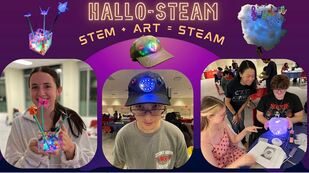
At Stony Brook (New York) University a collaboration between student and campus organizations aimed to bridge the gap between STEM (Science, Technology, Engineering and Mathematics) and the arts, making technical fields more accessible and engaging for students of all majors. They launched their effort at an event, Hallo-STEAM, which featured three unique projects, each designed to showcase the fusion of technology and creativity that can be built by anyone even if they are not “tech-savvy.”
“We have planned several events for elementary and high schoolers together that meld STEM and art (STEAM), specifically exploring how origami techniques can inspire engineering design. This event was therefore a natural progression for us and paired well with our goal of showcasing the interdisciplinary nature of STEM and art to audiences with little prior experience in STEM,” said Elizabeth Argiro, a biology major who heads the school’s Interactive Origami Club. The Hallo-STEAM event incorporated traditional origami, programming, and electronics. Attendees made flower vases with glowing origami tulips, lilies, and butterflies that lit up when you clap.
According to Rachel Leong, president of Stony Brook’s, Institute of Electrical and Electronics Engineers, the program was a great opportunity to introduce circuits and coding to people who might not otherwise know much about it. “The combination of art and technology excites us, and we are thrilled to see more people interested in these fields,” she said. Read the full article HERE.
Beetlejuice production partners with Dallas schools to teach STEAM skills

Over the course of multiple weeks, 3,400 theatre students and teachers from 26 Dallas High Schools will participate in a specially created curriculum that connects to the Broadway Dallas production of Beetlejuice, the musical adaptation of Tim Burton’s film. Taught by Broadway Dallas teaching artists, as part of the lesson plan all the participating students and teachers will attend a dedicated performance of the musical, which runs February 20-March 3, 2024.
The curriculum was developed to prepare students for college and 21st-century careers and includes a sequence of lesson plans where students will learn the art and science of hand drafting, which in the theater is used for scenic design. Through hand-drafting, students will apply basic principles of scales, measurement units, and physics, developing fundamental skills can be transferred to the construction, engineering, and architecture industries. Read the full article HERE.
The curriculum was developed to prepare students for college and 21st-century careers and includes a sequence of lesson plans where students will learn the art and science of hand drafting, which in the theater is used for scenic design. Through hand-drafting, students will apply basic principles of scales, measurement units, and physics, developing fundamental skills can be transferred to the construction, engineering, and architecture industries. Read the full article HERE.
Winnipeg STEAM project INSPIRES young children
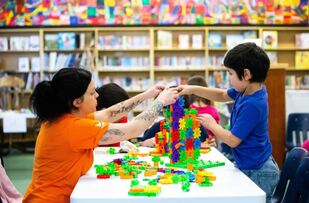
Young Designers, a Winnipeg, Canada program, employs a trio STEAM support teachers who travel from school to school to provide a six-week program to nursery-to-Grade 2 students. Each 90-minute weekly session, which typically runs from 3:30 p.m. to 5 p.m., begins with free play and ends with a group dinner. Participants spend the bulk of the time in a group read-aloud and a related STEAM design challenge inspired by the week’s storybook. One assignment involved brainstorming about a fictional species and accompanying habitat. Chicoine’s youngest child came up with a creature who is half-dinosaur, half-gorilla and lives in a forest surrounded by an abundance of grass for the fantastic vegetarian to eat.
During the 90-minute sessions, children and their caregivers play with light tables, robots, gear-building kits, pipe cleaners and geometric puzzles, among other crafty and constructible items that promote creativity and fine-motor skill development.
The program received $500,000 via the province’s strengthening student support and learning grant program to get the extracurricular off the ground. Participating schools receive STEAM kits, books. and professional development. In addition to being fed, every family takes home a copy of the storybook of the week. Read the full article HERE.
During the 90-minute sessions, children and their caregivers play with light tables, robots, gear-building kits, pipe cleaners and geometric puzzles, among other crafty and constructible items that promote creativity and fine-motor skill development.
The program received $500,000 via the province’s strengthening student support and learning grant program to get the extracurricular off the ground. Participating schools receive STEAM kits, books. and professional development. In addition to being fed, every family takes home a copy of the storybook of the week. Read the full article HERE.
How the maker movement is changing education
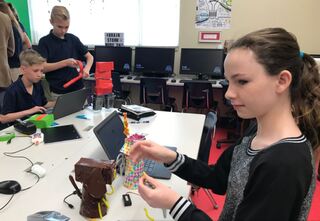
In Salt Lake City makerspaces are flourishing. Makerspaces are known as places where people, or “makers,” create, or “make,” projects using a variety of hands-on and digital tools. Commonly found at some libraries, museums, colleges and at places like the Utah STEM Action Center, the number of these spaces for open exploration have increased, especially in schools, which has given students equal access as well as gain skills in STEAM—science, technology, engineering, arts and mathematics.
At the Utah Action Center, students have opportunities for hands-on making, creating, designing, and innovating that bring individuals together in a variety of mediums, including robotics, textile crafts, woodcrafts, and electronics.
“Makerspaces need to be available and accessible,” said teacher Beth McKinney, who helped open the makerspace in Salt Lake’s Murray’s Hillcrest Junior High this fall. “It’s important for kids to have a place where they can explore their own interests, talents, curiosities and have that experience on their own with the freedom to do it in a safe, controlled setting. Many students might not have the tools, the confidence, or the opportunity to do so, so it’s important we have a safe space where any student can create and many learn best by doing, with their own hands.” Read the full article HERE.
At the Utah Action Center, students have opportunities for hands-on making, creating, designing, and innovating that bring individuals together in a variety of mediums, including robotics, textile crafts, woodcrafts, and electronics.
“Makerspaces need to be available and accessible,” said teacher Beth McKinney, who helped open the makerspace in Salt Lake’s Murray’s Hillcrest Junior High this fall. “It’s important for kids to have a place where they can explore their own interests, talents, curiosities and have that experience on their own with the freedom to do it in a safe, controlled setting. Many students might not have the tools, the confidence, or the opportunity to do so, so it’s important we have a safe space where any student can create and many learn best by doing, with their own hands.” Read the full article HERE.
creating innovation challenges for students
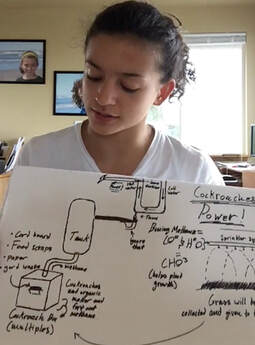
The purpose of science competitions or science fairs in STEM education is to provide students with opportunities to experience and practice science as it is practiced and experienced in the real world. A Framework for K–12 Science Education argues that the principal aim of science is to create and critique evidence-based causal accounts of natural phenomena (NRC 2012). To support this, the Next Generation Science Standards have outlined “science practices” as a guide for reproducing authentic science learning in the classroom (NGSS Lead States 2013). Further, the Frameworks suggests that science progresses through discourse within the community of scientists and emphasizes that students should learn to communicate and argue about information and findings "clearly and persuasively" (NRC 2012 p. 53). So, how can authentic science experiences be supported in classrooms?
To answer that question the independent research-based non-profit TERC, has created the Innovate to Mitigate project, which hosts open innovation challenges nationally for young people ages 13–18 to develop methods for mitigating global climate change. Past submissions have included projects in a wide range of domains (e.g., energy conservation, alternative energy generation, agricultural methods, or social/behavioral change). Read the full article HERE.
To answer that question the independent research-based non-profit TERC, has created the Innovate to Mitigate project, which hosts open innovation challenges nationally for young people ages 13–18 to develop methods for mitigating global climate change. Past submissions have included projects in a wide range of domains (e.g., energy conservation, alternative energy generation, agricultural methods, or social/behavioral change). Read the full article HERE.
Providing culturally relevant STEM pedagogy
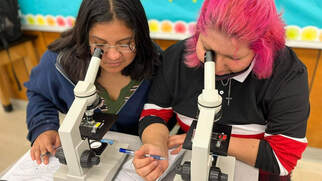
The Noyce STEM INSPIRES program, a collaboration between West Oso ISD, Texas A&M Corpus Christi, and the International Ocean Discovery Program (IODP). Texas A&M Corpus Christi, focused on providing secondary STEM teachers culturally relevant pedagogy for diverse student populations. The main goal of the NSF Noyce Scholarship program is to recruit, train, prepare, and retain highly effective elementary and secondary mathematics and science teachers (i.e., Noyce Scholar undergraduate teacher candidates) and teacher leaders in high-needs districts.
Students participate in educational experiences that implement critical service-learning projects, reinforcing STEM grades 7–12 education for underrepresented groups in high-needs schools. Critical service learning is different than traditional service learning with its three-pronged approach. The community learning component provides experiences with community mentors, and university faculty with the Noyce INSPIRES team including West Oso ISD teachers. The program emphasizes the power of community and forge relationships between school district stakeholders, teacher candidates, and key community members for teacher candidates to become agents of change in their communities.
In the first year of the grant, the Noyce INSPIRES team was able to partner with the International Ocean Discovery Program (IODP) and the Corpus Christi Museum of Science and History on a critical service-learning project benefiting the entire community. A local teacher who was a former director of educational activities for the IODP’s Deep Earth Academy was instrumental in bringing the NSF-funded, pop-up science exhibit In Search of Earth’s Secrets to West Oso ISD. The teacher worked aboard the IODP research vessel, JOIDES Resolution. The project intentionally requires the exhibit to travel to an accessible community site. Read the full article HERE.
Students participate in educational experiences that implement critical service-learning projects, reinforcing STEM grades 7–12 education for underrepresented groups in high-needs schools. Critical service learning is different than traditional service learning with its three-pronged approach. The community learning component provides experiences with community mentors, and university faculty with the Noyce INSPIRES team including West Oso ISD teachers. The program emphasizes the power of community and forge relationships between school district stakeholders, teacher candidates, and key community members for teacher candidates to become agents of change in their communities.
In the first year of the grant, the Noyce INSPIRES team was able to partner with the International Ocean Discovery Program (IODP) and the Corpus Christi Museum of Science and History on a critical service-learning project benefiting the entire community. A local teacher who was a former director of educational activities for the IODP’s Deep Earth Academy was instrumental in bringing the NSF-funded, pop-up science exhibit In Search of Earth’s Secrets to West Oso ISD. The teacher worked aboard the IODP research vessel, JOIDES Resolution. The project intentionally requires the exhibit to travel to an accessible community site. Read the full article HERE.
The Collaborative newsletters have been featuring conversations among its Research Thought Leaders, who are nationally and internationally recognized experts in their respective fields of arts, sciences, creativity, and neuroscience. These conversations provide robust insights into the importance of creative (a novel idea) and innovative (applying the novel idea to solve a problem) thinking.
This article builds on those insights to offer a look at how creative and innovative thinking could be used in K-12 classrooms. In the following articles, we will look at how curriculum could change to provide these important skills, what administrators need to know about them, and why we should care about STEAM, which fosters these skills.
We invited the Collaborative’s Innovation Fellows to offer their perspectives. The Fellows are top K-12 arts, STEM, and classroom teachers and administrators from across the U.S. who help lead the Collaborative’s K-12 STEAM efforts.
Charles Hayes, formerly a 5th grade science teacher, is advisor for middle school science in Memphis-Shelby County schools. Anne Ludes, a graduate of the Collaborative’s STEAM Teacher/Administrator Professional Development program, is Director of the Massachusetts Academy of Math and Science at Worcester Polytechnic Institute. Ashley Lupfer is K-8 Visual Arts Educator at Brooke Charter Schools in Boston, MA. Kimberly Olson is Visual Arts Educator at Centre School in Hampton, New Hampshire. Julie Olson, formerly a high school science teacher, is now Natural Science Instructor at Southeast Technical College in Sioux Falls, SD. Kathleen Sweet, former elementary school Art Educator, is now Student Improvement Coordinator and Computer Science Teacher (grades 2-5) for Starmont Community School District, IA.
Below are questions and valuable insights from these educators and administrators.
1. How could/do you use creative thinking in STEAM in your classroom, school, or work environment?
Charles Hayes
One of my responsibilities as the middle school science advisor in my district is to develop curriculum that allows instructors to encourage creativity and innovation in the pupils. As a result, I rely on guidance presented in A Framework for K-12 Science Education: Practices, Crosscutting Concepts, and Core Ideas (2012), which suggests that the best to way to teach science is to construct lessons around science and engineering practices, crosscutting concepts, and disciplinary core ideas.
“The science and engineering practices mentioned in this work and the Collaborative’s Effective Practices Higher-Level Thinking Skills have a lot of commonalities.”
My intentionality in lesson planning for our teachers, based on lessons that best support and highlight these skills, ensures that they have the resources, plans, and support they need to engage our children in meaningful hands-on experimental and project-based activities that shift away from rote memory assignments and toward activities that allow them to be creative, develop soft skills, and improve their scientific literacy. A lot of our lessons require students to create new ways of looking at existing phenomena. We challenge them to come up with different approaches to explaining the phenomena and new ways to test ideas and also to generate new ideas and thought-provoking questions based on their findings. We use statements such as “What if…, I wonder what would happen if…, Is there a different way…”.
Anne Ludes
Our teachers constantly redesign their units to make sure the content is fresh and relevant to our students. This means analyzing data and incorporating feedback so the students get as much out of their work as possible. Nearly everything we do is project- or inquiry-based.
“This allows our teachers to start their lesson planning with "What if I do this instead?" as the way they prepare for an upcoming unit.”
Everyone collaborates with each other, so teachers bounce ideas off everyone else—me as the director, the school counselor, other teachers, and the students - to work out the details. And this philosophy is at the heart of our school culture: Think creatively, reinvent yourself, take risks, and stretch yourself to grow as much as you can!
Our Humanities teacher delivers a lesson on Tom Stoppard's Arcadia (a brilliant play that I highly recommend if you haven't read it already!) and integrates the concepts of entropy, fractals, and chaos theory into her instruction (co-taught by a me, a former math teacher and now director of the program). The students' reflections and final projects are all unique and creative representations of their understanding of these concepts. Some projects take the form of a poem, a musical composition, a computer program, or even a board game.
Julie Olson
In the sciences, there are so many abstract ideas (e.g. the atom) that students need to be able to visualize in their heads. Space, color, and arrangement all help to "arrange" the parts of these not really seen entities. I give students a variety of materials when doing projects - the more the better. Sometimes/oftentimes they are initially overloaded, but then categorize, visualize, and start to put some of these things together in their heads before actually testing and building.
“My Physics students do the Art and Light project with the addition of describing the physics of their projects (e.g. reflection, wavelength, color) as well as the biology of vision. They have to make their projects in this unit aesthetically pleasing and engaging.”
They also create marble runs at the end of the semester with requirements taken from the various units (e.g. waves, potential and kinetic energy). Environmental Science discusses the aesthetics of good conservation. The students have many open-ended experiments that require them to visualize, assemble, and communicate their findings in graphs, charts, and diagrams. Anatomy and Physiology classes are tasked with creating an assist device for someone that cannot grasp a pen, pencil, marker, or paintbrush so they can use it in art class. The device must be comfortable, look good, and appeal to a young pre-teen.
Kimberly Olson
Creative thinking is the very basis of my entire elementary curriculum.
“Students respond to open-ended lesson problems to apply the design thinking process which so closely mirrors the science inquiry process.”
Students apply lesson objectives as “I Can” statements derived from the standards to formulate their own individual responses. Some responses may lead to collaboration, innovation, and extended learning. Social emotional learning is supported throughout and contributes to perseverance, autonomy, and grit. Student artists are observers, observing and asking questions. They also visually analyze, define, and clarify a problem, shift between perspectives based on discipline connections, and make connections to their own interests in order to generate ideas to develop solutions. Along the way they communicate in a variety of ways, collaborate, persist, and assist as necessary to an end based on a rich and inspired journey.
Kathleen Sweet
You can use creative thinking in every subject, classroom, or work environment.
“This type of thinking promotes engagement and keeps things moving forward, not becoming stagnant.”
An example: Co-teaching with the art, science, and language arts teachers. Using bacteria to paint original art and using writing to communicate and explain your thoughts and ideas. You would be learning about science, art, and writing and developing all those skills simultaneously.
2. How could/do you use innovative thinking in STEAM in your classroom, school, or work environment?
Charles Hayes
“Our district recognizes the value of Project-Based Learning (PBL) in developing our kids’ inventive abilities.”
We are planning several science competitions in which students will consider local, regional, and national issues and research related to these issues. Students will develop innovative and novel approaches to addressing these issues based on information and thinking skills developed in our classrooms.
Ashley Lupfer
“Providing students time in the classroom to create and innovate is essential.”
Time to understand a problem, to experiment with new tools and materials, and to work with their peers to develop original ideas. When students are learning within a culture of creativity, they have time to become more invested in the learning, are more comfortable expressing their ideas, and are more open to taking risks. In my classroom, activities often provide a balance of choice and structure.
Anne Ludes
“Our program is all about innovative thinking!”
For example, our students' first project in their computer science class is to use HTML and CSS to develop their own websites from scratch! They have to think about color (RGB), formatting, design, images, organization and layout, as well as content. And their final products are BEAUTIFUL and informative. But it doesn't stop there! In their STEM class, our students put their engineering design skills to good work when they develop and build an assistive device to help a client in need. The students have to work collaboratively to address a person's disability while thinking about utility, cost of materials, and the person's individual needs. Students use so many of their higher-level thinking skills, including defining a problem, generating and evaluating ideas, synthesizing, developing a solution, and persisting. And all the while they also are becoming more aware of the lives of others.
Julie Olson
More open-ended experiments and engineering projects. Student choice is necessary.
Kimberly Olson
Students approach all problem-solving aspects of lessons secure in the knowledge that “there are no mistakes in Art.” They work to imagine and develop their own personal responses to lesson problems and often, serendipitously, their work transcends creativity to elements of innovation. This occurs through collaborative work at the elementary level as well. Creating a safe, student-reflective curriculum, classroom community, and learning environment establishes the climate students need to feel able to take risks, revise, share, and elaborate or extend ideas and learning.
“Basing learning on student interest and identity establishes the right conditions for creativity to move closer toward innovative thinking and doing.”
Kathleen Sweet
“I believe that giving open-ended directions or parameters with enough direction to start with an idea but end up with a new one helps to promote innovative thinking.”
An example: To pair up two or more people and give them a piece of paper, 12 inches of tape, and scissors. Then ask them to make something using these materials. The outcomes would be infinite, even though every group received the same materials and directions.
Thanks to our esteemed Innovation Fellows for sharing their insights and especially for their creative and innovative efforts that inspire us all.
This article builds on those insights to offer a look at how creative and innovative thinking could be used in K-12 classrooms. In the following articles, we will look at how curriculum could change to provide these important skills, what administrators need to know about them, and why we should care about STEAM, which fosters these skills.
We invited the Collaborative’s Innovation Fellows to offer their perspectives. The Fellows are top K-12 arts, STEM, and classroom teachers and administrators from across the U.S. who help lead the Collaborative’s K-12 STEAM efforts.
Charles Hayes, formerly a 5th grade science teacher, is advisor for middle school science in Memphis-Shelby County schools. Anne Ludes, a graduate of the Collaborative’s STEAM Teacher/Administrator Professional Development program, is Director of the Massachusetts Academy of Math and Science at Worcester Polytechnic Institute. Ashley Lupfer is K-8 Visual Arts Educator at Brooke Charter Schools in Boston, MA. Kimberly Olson is Visual Arts Educator at Centre School in Hampton, New Hampshire. Julie Olson, formerly a high school science teacher, is now Natural Science Instructor at Southeast Technical College in Sioux Falls, SD. Kathleen Sweet, former elementary school Art Educator, is now Student Improvement Coordinator and Computer Science Teacher (grades 2-5) for Starmont Community School District, IA.
Below are questions and valuable insights from these educators and administrators.
1. How could/do you use creative thinking in STEAM in your classroom, school, or work environment?
Charles Hayes
One of my responsibilities as the middle school science advisor in my district is to develop curriculum that allows instructors to encourage creativity and innovation in the pupils. As a result, I rely on guidance presented in A Framework for K-12 Science Education: Practices, Crosscutting Concepts, and Core Ideas (2012), which suggests that the best to way to teach science is to construct lessons around science and engineering practices, crosscutting concepts, and disciplinary core ideas.
“The science and engineering practices mentioned in this work and the Collaborative’s Effective Practices Higher-Level Thinking Skills have a lot of commonalities.”
My intentionality in lesson planning for our teachers, based on lessons that best support and highlight these skills, ensures that they have the resources, plans, and support they need to engage our children in meaningful hands-on experimental and project-based activities that shift away from rote memory assignments and toward activities that allow them to be creative, develop soft skills, and improve their scientific literacy. A lot of our lessons require students to create new ways of looking at existing phenomena. We challenge them to come up with different approaches to explaining the phenomena and new ways to test ideas and also to generate new ideas and thought-provoking questions based on their findings. We use statements such as “What if…, I wonder what would happen if…, Is there a different way…”.
Anne Ludes
Our teachers constantly redesign their units to make sure the content is fresh and relevant to our students. This means analyzing data and incorporating feedback so the students get as much out of their work as possible. Nearly everything we do is project- or inquiry-based.
“This allows our teachers to start their lesson planning with "What if I do this instead?" as the way they prepare for an upcoming unit.”
Everyone collaborates with each other, so teachers bounce ideas off everyone else—me as the director, the school counselor, other teachers, and the students - to work out the details. And this philosophy is at the heart of our school culture: Think creatively, reinvent yourself, take risks, and stretch yourself to grow as much as you can!
Our Humanities teacher delivers a lesson on Tom Stoppard's Arcadia (a brilliant play that I highly recommend if you haven't read it already!) and integrates the concepts of entropy, fractals, and chaos theory into her instruction (co-taught by a me, a former math teacher and now director of the program). The students' reflections and final projects are all unique and creative representations of their understanding of these concepts. Some projects take the form of a poem, a musical composition, a computer program, or even a board game.
Julie Olson
In the sciences, there are so many abstract ideas (e.g. the atom) that students need to be able to visualize in their heads. Space, color, and arrangement all help to "arrange" the parts of these not really seen entities. I give students a variety of materials when doing projects - the more the better. Sometimes/oftentimes they are initially overloaded, but then categorize, visualize, and start to put some of these things together in their heads before actually testing and building.
“My Physics students do the Art and Light project with the addition of describing the physics of their projects (e.g. reflection, wavelength, color) as well as the biology of vision. They have to make their projects in this unit aesthetically pleasing and engaging.”
They also create marble runs at the end of the semester with requirements taken from the various units (e.g. waves, potential and kinetic energy). Environmental Science discusses the aesthetics of good conservation. The students have many open-ended experiments that require them to visualize, assemble, and communicate their findings in graphs, charts, and diagrams. Anatomy and Physiology classes are tasked with creating an assist device for someone that cannot grasp a pen, pencil, marker, or paintbrush so they can use it in art class. The device must be comfortable, look good, and appeal to a young pre-teen.
Kimberly Olson
Creative thinking is the very basis of my entire elementary curriculum.
“Students respond to open-ended lesson problems to apply the design thinking process which so closely mirrors the science inquiry process.”
Students apply lesson objectives as “I Can” statements derived from the standards to formulate their own individual responses. Some responses may lead to collaboration, innovation, and extended learning. Social emotional learning is supported throughout and contributes to perseverance, autonomy, and grit. Student artists are observers, observing and asking questions. They also visually analyze, define, and clarify a problem, shift between perspectives based on discipline connections, and make connections to their own interests in order to generate ideas to develop solutions. Along the way they communicate in a variety of ways, collaborate, persist, and assist as necessary to an end based on a rich and inspired journey.
Kathleen Sweet
You can use creative thinking in every subject, classroom, or work environment.
“This type of thinking promotes engagement and keeps things moving forward, not becoming stagnant.”
An example: Co-teaching with the art, science, and language arts teachers. Using bacteria to paint original art and using writing to communicate and explain your thoughts and ideas. You would be learning about science, art, and writing and developing all those skills simultaneously.
2. How could/do you use innovative thinking in STEAM in your classroom, school, or work environment?
Charles Hayes
“Our district recognizes the value of Project-Based Learning (PBL) in developing our kids’ inventive abilities.”
We are planning several science competitions in which students will consider local, regional, and national issues and research related to these issues. Students will develop innovative and novel approaches to addressing these issues based on information and thinking skills developed in our classrooms.
Ashley Lupfer
“Providing students time in the classroom to create and innovate is essential.”
Time to understand a problem, to experiment with new tools and materials, and to work with their peers to develop original ideas. When students are learning within a culture of creativity, they have time to become more invested in the learning, are more comfortable expressing their ideas, and are more open to taking risks. In my classroom, activities often provide a balance of choice and structure.
Anne Ludes
“Our program is all about innovative thinking!”
For example, our students' first project in their computer science class is to use HTML and CSS to develop their own websites from scratch! They have to think about color (RGB), formatting, design, images, organization and layout, as well as content. And their final products are BEAUTIFUL and informative. But it doesn't stop there! In their STEM class, our students put their engineering design skills to good work when they develop and build an assistive device to help a client in need. The students have to work collaboratively to address a person's disability while thinking about utility, cost of materials, and the person's individual needs. Students use so many of their higher-level thinking skills, including defining a problem, generating and evaluating ideas, synthesizing, developing a solution, and persisting. And all the while they also are becoming more aware of the lives of others.
Julie Olson
More open-ended experiments and engineering projects. Student choice is necessary.
Kimberly Olson
Students approach all problem-solving aspects of lessons secure in the knowledge that “there are no mistakes in Art.” They work to imagine and develop their own personal responses to lesson problems and often, serendipitously, their work transcends creativity to elements of innovation. This occurs through collaborative work at the elementary level as well. Creating a safe, student-reflective curriculum, classroom community, and learning environment establishes the climate students need to feel able to take risks, revise, share, and elaborate or extend ideas and learning.
“Basing learning on student interest and identity establishes the right conditions for creativity to move closer toward innovative thinking and doing.”
Kathleen Sweet
“I believe that giving open-ended directions or parameters with enough direction to start with an idea but end up with a new one helps to promote innovative thinking.”
An example: To pair up two or more people and give them a piece of paper, 12 inches of tape, and scissors. Then ask them to make something using these materials. The outcomes would be infinite, even though every group received the same materials and directions.
Thanks to our esteemed Innovation Fellows for sharing their insights and especially for their creative and innovative efforts that inspire us all.
what is steam to you?
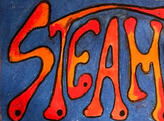
In education, STEAM (Science, Technology, Engineering, Arts, and Math) is a rapidly growing strategy in many learning settings. In can be found in K-12 classrooms, in museums and other out-of-school-time venues, in higher education, and even in educational toy product development.
In practice, STEAM takes many different forms. It accomplishes different goals, depending on its usage.
The Innovation Collaborative’s STEAM goals are to provide a strong research base for STEAM effective practices in K-12 and out-of-school-time experiences, lessons, and strategies. The Collaborative also is focused on effective collaboration across disciplines and learning settings.
In this role, the Collaborative is interested in how others perceive STEAM.
Join us in this quest to understand STEAM more deeply by sharing YOUR ideas of what STEAM is. Answer any or all of the above questions. You can respond briefly or in depth, but please limit your response to 300 words or less.
To get a start on your answers to the above questions, review the Collaborative’s position on STEAM at http://www.innovationcollaborative.org/steam-position.html
Click on this link or use the QR code to respond.
In practice, STEAM takes many different forms. It accomplishes different goals, depending on its usage.
The Innovation Collaborative’s STEAM goals are to provide a strong research base for STEAM effective practices in K-12 and out-of-school-time experiences, lessons, and strategies. The Collaborative also is focused on effective collaboration across disciplines and learning settings.
In this role, the Collaborative is interested in how others perceive STEAM.
- What is STEAM?
- Why is STEAM important in today’s rapidly changing world?
- How can STEAM help promote vital creative (a novel idea) and innovative (applying the novel idea to accomplish a goal) thinking skills?
Join us in this quest to understand STEAM more deeply by sharing YOUR ideas of what STEAM is. Answer any or all of the above questions. You can respond briefly or in depth, but please limit your response to 300 words or less.
To get a start on your answers to the above questions, review the Collaborative’s position on STEAM at http://www.innovationcollaborative.org/steam-position.html
Click on this link or use the QR code to respond.
perceptions of steam
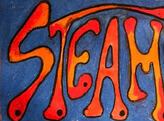
As we look at perceptions of STEAM in this newsletter issue, it is helpful to look at some of the work that already has been done to understand the many lenses through which STEAM is perceived.
Important work in this area has been done by the Arts Education Partnership (AEP). A national network of organizations that helps advance arts education, AEP focuses on research, policy, and practice. Below are some STEAM policy briefs that AEP has produced.
Preparing Students for Learning, Work and Life.
P-5 STEAM Education and Equity.
Research and Policy Implications of STEAM Education for Young Students.
Who’s Who in STEAM Education and State Governance.
Important work in this area has been done by the Arts Education Partnership (AEP). A national network of organizations that helps advance arts education, AEP focuses on research, policy, and practice. Below are some STEAM policy briefs that AEP has produced.
Preparing Students for Learning, Work and Life.
P-5 STEAM Education and Equity.
Research and Policy Implications of STEAM Education for Young Students.
Who’s Who in STEAM Education and State Governance.
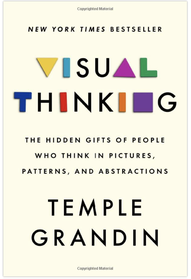
By David Pyle, Collaborative Advisory Council member*
"I'm very concerned that the visual thinking mind - the art mind — is being screened out of school,” said Dr. Temple Grandin during a rapid-fire widely broadcast interview hosted as a partnership between the Colorado State University Arts Management program and the International Art Materials Trade Association (NAMTA).
On February 23, I had the pleasure and privilege of hosting this special Zoom-based conversation with Dr. Grandin as she discussed the principles in her new book, Visual Thinking; The Hidden Gifts of People Who Think in Pictures, Patterns, and Abstractions. In her book — and during the Zoom-based program - she repeatedly emphasized the critical importance of learning in the arts — not just for their standalone value — but also for their impact in cultivating skills for which our larger communities and economy have a direct and dramatic need.
"We're seeing a gigantic shortage in the skilled trades — and those are where we need the art mind," she said.
Dr. Grandin is a professor of animal science at Colorado State University and the author of New York Times bestsellers Animals in Translation, Animals Make us Human, The Autistic Brain and Thinking in Pictures, which became an HBO movie starring Claire Danes.
"When I was a child, art was my absolutely favorite class. Art and mechanics go together," noted Dr. Grandin. "(But now) we've got too many kids who have never done any art. Who have never used any tool. We are losing skills! We've lost the clever fixers!"
She also cites sewing as a powerful skill-building tool. "I sewed costumes for the school play. I was not interested in being IN the school play. I wanted to make costumes FOR the school play."
In her book, Visual Thinking, Dr. Grandin adds, "We screen out designers, inventors, and artists. We need future generations who can build and repair infrastructure, overhaul energy and agriculture, create tools to combat climate change and pandemics, develop robotics and AI. We need people with the imagination to invent our next-generation solutions." (Visual Thinking, p. 55)
As further evidence of the need for arts experiences, she noted that "Nobel prize winners are 50% more likely to have an arts and craft hobby compared to other scientists." (Robert Root Bernstein et.al. 2008)
As the session approached its close, I asked her, "You've made such a strong and compelling case for hands-on arts education, how can we move past preaching to the choir? How can we advocate for arts education to the larger community?"
She quickly answered, "I think we have to do it one school district at a time. And then we need to write about it."
*David Pyle is an artist and Instructor in the Colorado State University Arts Management program in addition to being Creative Director of Pyle Creative Studio. He is known for his 35-year career in the art products business. There he most recently was Senior Vice President/Group Publisher for F+W Media, managing The Artist’s Magazine, American Artist, Watercolor Artist, Interweave Knits, Love of Quilting, and more. He is author of What Every Artist Needs to Know About Paints and Colors.
"I'm very concerned that the visual thinking mind - the art mind — is being screened out of school,” said Dr. Temple Grandin during a rapid-fire widely broadcast interview hosted as a partnership between the Colorado State University Arts Management program and the International Art Materials Trade Association (NAMTA).
On February 23, I had the pleasure and privilege of hosting this special Zoom-based conversation with Dr. Grandin as she discussed the principles in her new book, Visual Thinking; The Hidden Gifts of People Who Think in Pictures, Patterns, and Abstractions. In her book — and during the Zoom-based program - she repeatedly emphasized the critical importance of learning in the arts — not just for their standalone value — but also for their impact in cultivating skills for which our larger communities and economy have a direct and dramatic need.
"We're seeing a gigantic shortage in the skilled trades — and those are where we need the art mind," she said.
Dr. Grandin is a professor of animal science at Colorado State University and the author of New York Times bestsellers Animals in Translation, Animals Make us Human, The Autistic Brain and Thinking in Pictures, which became an HBO movie starring Claire Danes.
"When I was a child, art was my absolutely favorite class. Art and mechanics go together," noted Dr. Grandin. "(But now) we've got too many kids who have never done any art. Who have never used any tool. We are losing skills! We've lost the clever fixers!"
She also cites sewing as a powerful skill-building tool. "I sewed costumes for the school play. I was not interested in being IN the school play. I wanted to make costumes FOR the school play."
In her book, Visual Thinking, Dr. Grandin adds, "We screen out designers, inventors, and artists. We need future generations who can build and repair infrastructure, overhaul energy and agriculture, create tools to combat climate change and pandemics, develop robotics and AI. We need people with the imagination to invent our next-generation solutions." (Visual Thinking, p. 55)
As further evidence of the need for arts experiences, she noted that "Nobel prize winners are 50% more likely to have an arts and craft hobby compared to other scientists." (Robert Root Bernstein et.al. 2008)
As the session approached its close, I asked her, "You've made such a strong and compelling case for hands-on arts education, how can we move past preaching to the choir? How can we advocate for arts education to the larger community?"
She quickly answered, "I think we have to do it one school district at a time. And then we need to write about it."
*David Pyle is an artist and Instructor in the Colorado State University Arts Management program in addition to being Creative Director of Pyle Creative Studio. He is known for his 35-year career in the art products business. There he most recently was Senior Vice President/Group Publisher for F+W Media, managing The Artist’s Magazine, American Artist, Watercolor Artist, Interweave Knits, Love of Quilting, and more. He is author of What Every Artist Needs to Know About Paints and Colors.
Free Summer Virtual STEAM Professional Development for Public School K-12 Teachers
Deadline to sign up approaching
Chibitronics, a company that blends the technology of paper circuits with arts, crafts, and creativity, is offering free virtual STEAM professional development to public K-12 teachers this summer. The times are: 1-4 ET. The dates for the courses are: Course A: July 10 to July 19; Course B: July 24 to Aug 2.
In this training, participants take a deep dive into STEAM through the lens of paper circuits by using Chibitronics’ circuit stickers. Teachers receive supplies to take back to the classroom.
This course is part of the Pathfinders Summer Online Institute, generously funded by Infosys Foundation USA.
In talking about this opportunity, Jie Qi, Chibitronics’ CEO, said, “Chibitronics is excited to offer this free virtual STEAM professional development to public K-12 teachers! All participating teachers will receive full scholarships and free supplies. Please register soon, as spots are limited. Deadline to register is May 31, 2023.”
To find out more, visit the Chibitronics’ summer PD webpage.
To register, go to the registration page. Registration closes May 31.
In this training, participants take a deep dive into STEAM through the lens of paper circuits by using Chibitronics’ circuit stickers. Teachers receive supplies to take back to the classroom.
This course is part of the Pathfinders Summer Online Institute, generously funded by Infosys Foundation USA.
In talking about this opportunity, Jie Qi, Chibitronics’ CEO, said, “Chibitronics is excited to offer this free virtual STEAM professional development to public K-12 teachers! All participating teachers will receive full scholarships and free supplies. Please register soon, as spots are limited. Deadline to register is May 31, 2023.”
To find out more, visit the Chibitronics’ summer PD webpage.
To register, go to the registration page. Registration closes May 31.
STEAM TEACHING RESOURCES FOR EDUCATORS
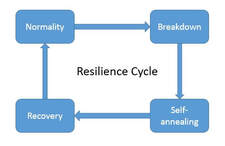
Resilient Educator is an online resource that accumulates STEAM ideas and resources for teachers. It includes current research, conferences, grant opportunities, and lesson plans. “Curricula opportunities range from taking planned STEM lessons and adding in an arts component or perspective, to developing STEAM plans that fully integrate arts education from the very start.”
STEAM Teaching Resources for Educators | Resilient Educator
STEAM Teaching Resources for Educators | Resilient Educator
ACTALENT CELEBRATES ENGINEERING DIVERSITY

Actalent celebrated engineering excellence and diversity at the 37th annual Black Engineer of the Year Award (BEYA) STEM Conference. Learn more about STEM career building.
Celebrating Engineering Excellence - BEYA 2023 (actalentservices.com)
Celebrating Engineering Excellence - BEYA 2023 (actalentservices.com)
NSTA CONFERENCE — ABOUT STEAM SESSIONS

The National Science Teaching Association met in Atlanta in March. Many sessions addressed disciplinary integration. Here is a quick sample of some of the offerings:
- And They Engineered Happily Ever After: Using Storybooks to Construct Engineering Units – This session presented a scaffolded framework for integrating social justice into intentional engineering design.
- STEMifying Storybooks: Integrating Engineering in the Elementary Classroom through Storybooks – A picture book became the basis for an engineering unit. Participants examined examples of several books used to construct a force and motion unit for the classroom.
- Musical Makers: Garbage Band – Participants designed their own musical instruments using “trash,” creating a Garbage Band complete with music videos.
- 5-6-7-8: How Dance Class Can Teach Us About Best Practices for Instruction – An inquiry-based dance class showcased key ideas that support all learners, using the power of kinesthetic learning, and more.
- From Pixel Art to Arcade in the Classroom – This session explored integrating a premade avatar or sprite from Pixel Art into a nostalgic video game.
THINKING ABOUT THE FUTURE

The switch to e-learning during the worst of the COVID years prompted increased attention to the potential and guidelines for the e-learning field.
In the article, the ideas below are detailed. How can the arts enhance these learning modalities?
In the article, the ideas below are detailed. How can the arts enhance these learning modalities?
- Big Data Analytics
- Virtual Reality
- Microlearning
- Personalized learning
- Cloud Based Learning
- Mobile Learning
- Social Learning
- Work-life Skills
- Adaptive Learning
- Artificial Intelligence
- Game-based Learning
The Collaborative’s Research Thought Leaders help provide the strong research foundation upon which the Collaborative’s work rests. Each Thought Leader is nationally and internationally recognized in their own field and brings an extensive depth of experience and expertise. They also are adept at working across disciplines.
In our previous newsletters, we brought you interviews with each of our Thought Leaders and also examined ways to apply their important ideas in STEAM learning. This new series showcases conversations between various Thought Leaders around an important and relevant topic. The spring and fall, 2022 newsletters featured a conversation about creativity and innovation between Neuroscience Thought Leader Sandi Chapman, PhD, and Creativity Thought Leader Bonnie Cramond, PhD. Sandi Chapman is Founder and Chief Director of the University of Texas at Dallas Center for BrainHealth. Bonnie Cramond is Professor Emerita of Educational Psychology and Gifted and Creative Education at the University of Georgia.
This article builds on those conversations between Chapman and Cramond. It is an interchange with important observations about creativity from the Collaborative’s Science Thought Leader Hubert Dyasi, PhD, and Arts Thought Leader Rob Horowitz, EdD, both of whom are leaders in their own fields. Hubert Dyasi is Professor of Science Education, the City College, City University of New York (CUNY) – retired. He is known for the teaching and learning of science in pre-college education in the US and in Africa (see newsletter for information about him and his recounting of how curiosity led to science centers across Africa). Rob Horowitz is Executive Director, ArtsResearch, and Associate Director, Center for Arts Education Research, Teachers College, at Columbia University. He is well-known for his arts education research that demonstrates the important relationships between in-school arts learning and cognitive, social, and personal competencies (see newsletter article for resources and information about him). In this interchange of ideas, you will see important commonalities between science and the arts in relation to the use of creative thinking.
Hubert Dyasi:
One of the major aspects of all science is the creation of science-based mental models that successfully explain and predict events in nature. Yet science lessons in schools seldom provide multiple rich opportunities for students to engage in meaningful development and critique of mental models. That is unfortunate.
I believe the impulse to create mental models is an integral part of human development and the desire to understand the world. In other words, all humans, including children, cannot help but create mental models in efforts to explain and understand their worlds. If we consistently use that impulse as a motivating factor in teaching and learning, we will have a firm foundation for cultivating understanding and creativity in students’ learning regardless of the school subject. The challenge in science education, specifically, is how to make students’ creation of mental models a staple of science learning for all students.
Rob Horowitz:
As Hubert and I often have found in our conversations, there is more commonality between the work of scientists and artists than differences. Developing mental models – and testing and revising them – is inherent to the artistic process, although the medium might be aural, sensual, visual, or kinesthetic, rather than linguistic and logical. These are processes inherent to our humanity, and not just the domain of those who are defined by the presence or absence of “talent". Children – and adults, for that matter – make meaning and understanding of their world through engaging the senses, seeking patterns, adding to previous knowledge through adjusting their mental models, and then seeking to express their understanding, ideas, and feelings. Their ensuing representation is “art”, for want of a better word.
Hubert Dyasi:
Building upon students’ impulse to create mental models also implies utilizing it to cultivate their creative capacity to raise questions that interest them, refine them in a manner that makes them scientifically investigable, and to design ways to answer them; for example, creativity about what data to collect, how to collect them, how to organize and interpret them, and about how to communicate them clearly and interestingly. If students grapple with their own thoughts and ideas to perform these tasks, they engage in creative activity. From banks of data analyses they have done, they learn to see patterns from which they create testable mental models — models they can use to explain and to predict events in specific aspects of their worlds. In other words, they learn to develop mental models based on data that meet standards of evidence in science.
Rob Horowitz:
I am still seeking to find differences between the artistic and scientific modeling processes — perhaps Hubert’s notion of testable mental models that can predict events can lead me to an answer. I will have to adjust my own mental model of artistic creation to consider this.
Hubert Dyasi:
By their very nature, mental models created from data based on science practices have “successes” and “failures.” As students encounter more events and generate more data, they might find discrepancies in their models; the discrepancies invite them to design ways to revise and refine the models. The resulting mental models are creative to the extent they are new to the students, and/or combine objects and ideas in ways that are new to them; it doesn’t matter that grownups might already know them.
Rob Horowitz:
The mental models are revised as the learner stays open to new information. That “resistance to closure” and task persistence is an asset as children develop and revise their models. One difference with the performing arts is the temporal quality, where revisions are made quickly, in real time, as rhythm and phrasing, dance steps, improvisations, or actor’s delivery are adjusted in real time in response to their community of fellow performers (and audience). Perhaps this is a key difference between the arts and sciences: the need to adjust the communication and artistic representation in response to others. Although I suspect Hubert will summon a parallel process in scientific exploration, such as the need to establish safe and nurturing classroom environments – or laboratories – that support open exploration and representation.
Hubert Dyasi:
It is important to note once again that embedded within creating mental models are other elements of creativity, e.g., self-created ways to represent and to communicate the models, and design of model-testing situations and devices. In these activities, students also gain a useful insight into science that it is a self-correcting system of studying phenomena of the world. None of these levels of creativity, however, can occur in classrooms without satisfying preconditions such as a psychologically safe classroom environments where students are comfortable expressing their ideas and creativity, and supportive curricula and assessments.
A special thank you to Hubert and Rob for these enlightening insights that help us see that the boundaries between the sciences and the arts are transcended in many important ways.
In our previous newsletters, we brought you interviews with each of our Thought Leaders and also examined ways to apply their important ideas in STEAM learning. This new series showcases conversations between various Thought Leaders around an important and relevant topic. The spring and fall, 2022 newsletters featured a conversation about creativity and innovation between Neuroscience Thought Leader Sandi Chapman, PhD, and Creativity Thought Leader Bonnie Cramond, PhD. Sandi Chapman is Founder and Chief Director of the University of Texas at Dallas Center for BrainHealth. Bonnie Cramond is Professor Emerita of Educational Psychology and Gifted and Creative Education at the University of Georgia.
This article builds on those conversations between Chapman and Cramond. It is an interchange with important observations about creativity from the Collaborative’s Science Thought Leader Hubert Dyasi, PhD, and Arts Thought Leader Rob Horowitz, EdD, both of whom are leaders in their own fields. Hubert Dyasi is Professor of Science Education, the City College, City University of New York (CUNY) – retired. He is known for the teaching and learning of science in pre-college education in the US and in Africa (see newsletter for information about him and his recounting of how curiosity led to science centers across Africa). Rob Horowitz is Executive Director, ArtsResearch, and Associate Director, Center for Arts Education Research, Teachers College, at Columbia University. He is well-known for his arts education research that demonstrates the important relationships between in-school arts learning and cognitive, social, and personal competencies (see newsletter article for resources and information about him). In this interchange of ideas, you will see important commonalities between science and the arts in relation to the use of creative thinking.
Hubert Dyasi:
One of the major aspects of all science is the creation of science-based mental models that successfully explain and predict events in nature. Yet science lessons in schools seldom provide multiple rich opportunities for students to engage in meaningful development and critique of mental models. That is unfortunate.
I believe the impulse to create mental models is an integral part of human development and the desire to understand the world. In other words, all humans, including children, cannot help but create mental models in efforts to explain and understand their worlds. If we consistently use that impulse as a motivating factor in teaching and learning, we will have a firm foundation for cultivating understanding and creativity in students’ learning regardless of the school subject. The challenge in science education, specifically, is how to make students’ creation of mental models a staple of science learning for all students.
Rob Horowitz:
As Hubert and I often have found in our conversations, there is more commonality between the work of scientists and artists than differences. Developing mental models – and testing and revising them – is inherent to the artistic process, although the medium might be aural, sensual, visual, or kinesthetic, rather than linguistic and logical. These are processes inherent to our humanity, and not just the domain of those who are defined by the presence or absence of “talent". Children – and adults, for that matter – make meaning and understanding of their world through engaging the senses, seeking patterns, adding to previous knowledge through adjusting their mental models, and then seeking to express their understanding, ideas, and feelings. Their ensuing representation is “art”, for want of a better word.
Hubert Dyasi:
Building upon students’ impulse to create mental models also implies utilizing it to cultivate their creative capacity to raise questions that interest them, refine them in a manner that makes them scientifically investigable, and to design ways to answer them; for example, creativity about what data to collect, how to collect them, how to organize and interpret them, and about how to communicate them clearly and interestingly. If students grapple with their own thoughts and ideas to perform these tasks, they engage in creative activity. From banks of data analyses they have done, they learn to see patterns from which they create testable mental models — models they can use to explain and to predict events in specific aspects of their worlds. In other words, they learn to develop mental models based on data that meet standards of evidence in science.
Rob Horowitz:
I am still seeking to find differences between the artistic and scientific modeling processes — perhaps Hubert’s notion of testable mental models that can predict events can lead me to an answer. I will have to adjust my own mental model of artistic creation to consider this.
Hubert Dyasi:
By their very nature, mental models created from data based on science practices have “successes” and “failures.” As students encounter more events and generate more data, they might find discrepancies in their models; the discrepancies invite them to design ways to revise and refine the models. The resulting mental models are creative to the extent they are new to the students, and/or combine objects and ideas in ways that are new to them; it doesn’t matter that grownups might already know them.
Rob Horowitz:
The mental models are revised as the learner stays open to new information. That “resistance to closure” and task persistence is an asset as children develop and revise their models. One difference with the performing arts is the temporal quality, where revisions are made quickly, in real time, as rhythm and phrasing, dance steps, improvisations, or actor’s delivery are adjusted in real time in response to their community of fellow performers (and audience). Perhaps this is a key difference between the arts and sciences: the need to adjust the communication and artistic representation in response to others. Although I suspect Hubert will summon a parallel process in scientific exploration, such as the need to establish safe and nurturing classroom environments – or laboratories – that support open exploration and representation.
Hubert Dyasi:
It is important to note once again that embedded within creating mental models are other elements of creativity, e.g., self-created ways to represent and to communicate the models, and design of model-testing situations and devices. In these activities, students also gain a useful insight into science that it is a self-correcting system of studying phenomena of the world. None of these levels of creativity, however, can occur in classrooms without satisfying preconditions such as a psychologically safe classroom environments where students are comfortable expressing their ideas and creativity, and supportive curricula and assessments.
A special thank you to Hubert and Rob for these enlightening insights that help us see that the boundaries between the sciences and the arts are transcended in many important ways.
| Melissa Collins | Charles Hayes | Anne Ludes | Carla Neely |
The Innovation Collaborative is proud to announce new Innovation Fellows who have been invited by the Board of Directors to join the Collaborative’s work in K-12.
Innovation Fellows are top K-12 administrators and arts, STEM, and classroom teachers from across the US who are influential STEAM advocates. They are the planning team who help lead the Collaborative’s K-12 Effective Practices project that focuses on classroom practices and teacher professional development.
The Collaborative’s initial Fellows were identified in the first round of national K-12 STEAM research. Additional fellows are invited to join this group, based on their impressive abilities to move the K-12 STEAM field forward through teaching and administration.
These new Fellows are impressive in their own right.
Innovation Fellows are top K-12 administrators and arts, STEM, and classroom teachers from across the US who are influential STEAM advocates. They are the planning team who help lead the Collaborative’s K-12 Effective Practices project that focuses on classroom practices and teacher professional development.
The Collaborative’s initial Fellows were identified in the first round of national K-12 STEAM research. Additional fellows are invited to join this group, based on their impressive abilities to move the K-12 STEAM field forward through teaching and administration.
These new Fellows are impressive in their own right.
- Melissa Collins has been an active member of the Collaborative’s Advisory Council since 2020. She teaches second grade at John P. Freeman Optional School, an underserved school in Memphis, TN. There, she emphasizes curiosity in science and is a teacher leadership expert. Melissa has won numerous awards, including the Presidential Award for Excellence in Science and Math Teaching, the National Science Teaching Association's (NSTA) Sylvia Shugrue Award for elementary teachers, and in 2020 was named to the National Teacher Hall of Fame.
- Charles Hayes has been the fifth grade science lead at a Title 1 School in Memphis TN for nine years. This year he is serving as instruction advisor for middle school science in the Memphis-Shelby County Schools’ Department of Curriculum and Instruction. He has won a number of awards, including the Presidential Award for Excellence in Science and Math Teaching and the National Science Teaching Association’s (NSTA) Shell Science Teacher Award. Charles embraces STEAM and the Collaborative’s work.
- Anne Ludes is a spring, 2021, graduate of the Collaborative's STEAM Professional Development (PD) and became a leader in planning our subsequent STEAM PDs. She was Assistant Superintendent for Secondary Education at Framingham Public Schools, MA, and is now Director of the Massachusetts Academy of Math and Science at Worcester Polytechnic Institute, MA. She is passionate about the Collaborative's approach to STEAM. She said, "This work has been absolutely game-changing for me... As an administrator, this project has been instrumental in helping me develop the language and depth of understanding necessary to support teachers with curriculum development, lesson planning, and instructional practices.”
- Carla Neely has been teaching fifth and sixth grade science at an African American all-girls school, Warner Girls Leadership Academy, in Cleveland, Ohio. She was one of 15 teachers across the US selected as 2022-23 Albert Einstein Distinguished Educator Fellows. As an Einstein Fellow, she is working as a STEM Legislative Fellow in a Nevada Senator's office in DC, developing ways to make STEM more equitable for girls of color, which is her specialty. Before her selection as an Einstein Fellow, she taught STEAM in her science classroom and developed a STEAM lab. She also conducted research regarding equity for girls in STEM.

How do research and perspectives on imaginative thinking in STEM education and practice relate to STEM learning in museums? That was an important question asked by the Museum of Science (MOS), Boston, in a project funded by the National Science Foundation’s (NSF) Advancing Informal STEM Learning (AISL) program.
To address this question, the MOS team, led by Becki Kipling, Principal Investigator, and Christine Reich and Sarah May, Co-Principal Investigators, brought together researchers, practitioners, educators, and others for a series of convenings. There were rich conversations about imagination between Informal Science Education (ISE) professionals and between ISE professionals and those from other domains. The Collaborative was included in these convenings. Many important insights were gained.
Enriching this work are a recently released literature review, a survey of ISE professionals, and a number of other products related to this topic. These can help identify and stimulate future areas of research.
See these rich Museum of Science, Boston resources to learn more about the convening’s proceedings, a framework for defining imagination in STEM, and a number of other important resources. You can find project descriptions from 25 unique projects that use imagination in a variety of ways in the Project Index. You can find the YouTube playlist at Unpacking the STEM Imagination Convening YouTube Playlist.
See also the Research Thought Leader article in this newsletter where the Collaborative’s Science Thought Leader, Hubert Dyasi, PhD, and its Arts Thought Leader, Rob Horowitz, EdD, discuss how creative thinking (which includes imagination) bridges the science and the arts.
To address this question, the MOS team, led by Becki Kipling, Principal Investigator, and Christine Reich and Sarah May, Co-Principal Investigators, brought together researchers, practitioners, educators, and others for a series of convenings. There were rich conversations about imagination between Informal Science Education (ISE) professionals and between ISE professionals and those from other domains. The Collaborative was included in these convenings. Many important insights were gained.
Enriching this work are a recently released literature review, a survey of ISE professionals, and a number of other products related to this topic. These can help identify and stimulate future areas of research.
See these rich Museum of Science, Boston resources to learn more about the convening’s proceedings, a framework for defining imagination in STEM, and a number of other important resources. You can find project descriptions from 25 unique projects that use imagination in a variety of ways in the Project Index. You can find the YouTube playlist at Unpacking the STEM Imagination Convening YouTube Playlist.
See also the Research Thought Leader article in this newsletter where the Collaborative’s Science Thought Leader, Hubert Dyasi, PhD, and its Arts Thought Leader, Rob Horowitz, EdD, discuss how creative thinking (which includes imagination) bridges the science and the arts.
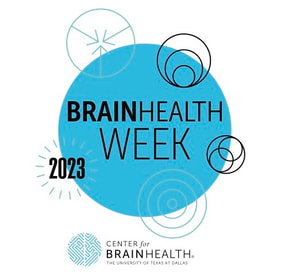
The Collaborative recently participated as a Community Partner in the highly successful BrainHealth Week sponsored by the University of Texas at Dallas Center for BrainHealth.
Held February 20-24, BrainHealth Week was a free of charge five-day interactive event where people of all ages were shown how to build habits that promote a healthier brain and improve the trajectory of their lives. This included both in-person and virtual experiences with expert speakers, engaging activities, and access to brain health habits that can become part of one’s daily routine.
The Center for BrainHealth’s Chief Director, Sandi Chapman, PhD, is the Collaborative’s Neuroscience Research Thought Leader who, along with three other Thought Leaders, help lead the Collaborative’s work conceptually. Through Sandi, the Collaborative’s work centers on vital research-based thinking skills that the Collaborative shares with students and teachers across the US.
According to the Center for BrainHealth, “cognitive neuroscience suggests that the trend of worsening brain outcomes, such as decline, disease, mental health disorders, despair, loneliness, and brain fog can be reversed. Healthier brain habits can change this. Intelligence, memory, cognitive function, and even mental health can be impacted by how we protect and train our brains. In a groundbreaking study of 187 adults of all ages, 80% saw an improvement in their BrainHealth index scores (a scientifically validated measure the of the brain’s holistic health and fitness). Participants who engaged the most with proactive brain health strategies experienced the largest gains.”
The cognitive neuroscience conducted at the Center for BrainHealth and other leading research institutes around the world clearly demonstrates that our brain’s health and performance can be affected by daily, proactive practices. When talking about Brain Health Week, Sandi said, “At the Center for BrainHealth, we are uniquely devoted to discovering and applying the latest scientific findings about the brain’s ability to change based on how we use it.” She added, “What good is science if people don’t know how to use it to make their lives better”?
You can find out more about how you can maximize your brain’s capacities at BrainHealth.
Held February 20-24, BrainHealth Week was a free of charge five-day interactive event where people of all ages were shown how to build habits that promote a healthier brain and improve the trajectory of their lives. This included both in-person and virtual experiences with expert speakers, engaging activities, and access to brain health habits that can become part of one’s daily routine.
The Center for BrainHealth’s Chief Director, Sandi Chapman, PhD, is the Collaborative’s Neuroscience Research Thought Leader who, along with three other Thought Leaders, help lead the Collaborative’s work conceptually. Through Sandi, the Collaborative’s work centers on vital research-based thinking skills that the Collaborative shares with students and teachers across the US.
According to the Center for BrainHealth, “cognitive neuroscience suggests that the trend of worsening brain outcomes, such as decline, disease, mental health disorders, despair, loneliness, and brain fog can be reversed. Healthier brain habits can change this. Intelligence, memory, cognitive function, and even mental health can be impacted by how we protect and train our brains. In a groundbreaking study of 187 adults of all ages, 80% saw an improvement in their BrainHealth index scores (a scientifically validated measure the of the brain’s holistic health and fitness). Participants who engaged the most with proactive brain health strategies experienced the largest gains.”
The cognitive neuroscience conducted at the Center for BrainHealth and other leading research institutes around the world clearly demonstrates that our brain’s health and performance can be affected by daily, proactive practices. When talking about Brain Health Week, Sandi said, “At the Center for BrainHealth, we are uniquely devoted to discovering and applying the latest scientific findings about the brain’s ability to change based on how we use it.” She added, “What good is science if people don’t know how to use it to make their lives better”?
You can find out more about how you can maximize your brain’s capacities at BrainHealth.
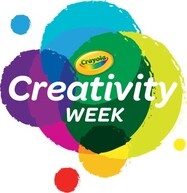
Crayola Creativity Week
Crayola recently held its highly successful Creativity Week. It engaged 3.5 million children and 195,000 teachers in 77 countries.
In talking about Creativity Week, Crayola Director of Education, Cheri Sterman, said, “At Crayola Education we strive to give children, educators, and parents resources and inspiration to help them create and learn, opening their imaginations so they can pursue their dreams. Within Crayola Creativity Week, we collaborated with many organizations and creative spokespersons to inspire kids around the world, including NASA, Penguin Random House, HarperCollins Publishers, Sony Pictures Home Entertainment, KIDZ BOP, GoNoodle, Khan Academy Kids, National Art Education Association, American Association of School Librarians, World Reader, Code.org, and the YMCA. Getting the word out about the power of creativity to help kids learn was a major objective of the celebration. Crayola is thrilled that the public tuned in to this message, with 615 million media impressions!”
Celebrity presenters included astronaut Ricky Arnold, who started his career as a middle school science educator and told kids how he needed creative thinking to be both a teacher and an astronaut, and Today Show meteorologist Dylan Dreyer, who talked about how creativity has been the guiding force in all her career decisions.
Visit the Creativity Week website for a wealth of teacher and parent resources. These include videos, read alongs, Thinking Sheets, creative challenges, and more.
Crayola recently held its highly successful Creativity Week. It engaged 3.5 million children and 195,000 teachers in 77 countries.
In talking about Creativity Week, Crayola Director of Education, Cheri Sterman, said, “At Crayola Education we strive to give children, educators, and parents resources and inspiration to help them create and learn, opening their imaginations so they can pursue their dreams. Within Crayola Creativity Week, we collaborated with many organizations and creative spokespersons to inspire kids around the world, including NASA, Penguin Random House, HarperCollins Publishers, Sony Pictures Home Entertainment, KIDZ BOP, GoNoodle, Khan Academy Kids, National Art Education Association, American Association of School Librarians, World Reader, Code.org, and the YMCA. Getting the word out about the power of creativity to help kids learn was a major objective of the celebration. Crayola is thrilled that the public tuned in to this message, with 615 million media impressions!”
Celebrity presenters included astronaut Ricky Arnold, who started his career as a middle school science educator and told kids how he needed creative thinking to be both a teacher and an astronaut, and Today Show meteorologist Dylan Dreyer, who talked about how creativity has been the guiding force in all her career decisions.
Visit the Creativity Week website for a wealth of teacher and parent resources. These include videos, read alongs, Thinking Sheets, creative challenges, and more.
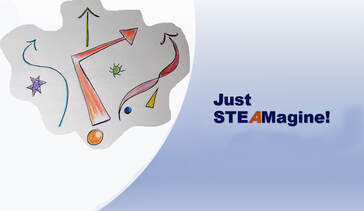
STEAM Imagination
By Merrie Koester, PhD, Collaborative Advisory Council Member
Pre-pandemic, I received a surprising email from education researcher, philosopher, and editor Dr. David Flinders: Dear Dr. Koester, You have been invited to submit a commentary for Routledge Encyclopedia of Education. I would be grateful if your commentary were entitled "Science Curriculum." To say I was stunned by the invitation would be an understatement. First of all, the challenge to write an encyclopedia entry of any kind implied I had the authority to do so. Does anyone? I also recalled believing as a child that the World Book Encyclopedia was a Great Repository of Truth. And then I reflected on the problem of names and the energy of language. To name something is to stake a claim of knowing its signification. This is a responsibility the Innovation Collaborative has not taken lightly as we’ve labored over what we “mean” when we say STEAM, creativity, innovation, transdisciplinary, etc.
Next, I thought about how this this human endeavor we call Science is not about getting things right, but rather about getting them less wrong, using the best evidence available to one at the time. Similarly, the Innovation Collaborative’s work—the research and the practices—don’t just tell what STEAM is, they SHOW how STEAM thinks and performs!
Next, I thought about how this this human endeavor we call Science is not about getting things right, but rather about getting them less wrong, using the best evidence available to one at the time. Similarly, the Innovation Collaborative’s work—the research and the practices—don’t just tell what STEAM is, they SHOW how STEAM thinks and performs!
As background, I was invited to present a paper at the 2016 American Educational Research Association (AERA) conference for a session called Eisner in Mind: Fresh Perspectives on Inquiry and Education. During my talk, entitled “Imagination and the Arts as Antidotes for STEM Education Malaise and Alienation”, I recalled scientist James Trefil’s writing about “The Great Turn Off” to school science, a disheartening event that occurs sometime around middle school and which Trefil attributed to a near total lack of creativity in traditional science teaching. I didn’t need to convince this room of creatives at AERA that something needed to be done! Like Trefil, I lament the dire consequences of a science illiterate nation.
Making science accessible and meaningfully engaging to all students is an ill-structured problem at best, one beset with issues of power, culture, and privilege, and the ever-present requirement that students meet performance benchmarks on content knowledge standards. When a science class is named a STEAM studio, students get to see that the very act of doing science requires a curious, creative mind and heart. Through noticing, listening, attending, and personal story-making – leaning in – science learning begins to matter.
And so I accepted the challenge from Routledge, but respectfully asked (and was approved) to change the entry’s title to “Progressive Science Education Curriculum.” I also asked if my colleague, Dr. Meta Van Sickle, might join me as a thought partner. Between us, Meta and I have devoted over sixty years to the research and practice of “Science Curriculum” as a “creative making practice”, decades before anyone named STEAM as educational practice. In 2018, Meta and her colleague, Dr. Judith Batzler, working with IGI, edited Cases on STEAM Education in Practice, to which I also contributed.
Gradually, the work for Routledge progressed, in just the same messy, organic way that all creative making requires. During the pandemic, the publishers themselves got creative with the platform, deciding to launch the project under a new name, Routledge Resources Online — Education, in order to better describe the scope of the product and to pivot to an increasingly virtual, post-pandemic world of readers. And now, I’m happy to share that at long last, Progressive Science Education Curriculum has been published! Being part of this incredible collective called the Innovation Collaborative has fueled my hope that we may have finally arrived at a time when we can design and put into practice truly educative and progressive models that provide joyful time and space for creative making and thinking. The Collaborative outreach/research is providing strong evidence to support the claim that STEAM learning experiences, those that are inclusive, empowering, emergent, and creative — not just numbers-based, procedure-driven, and geared toward mastery of knowledge that will be on a test — matter! Just STEAMagine where we’ll go from here!
Merrie Koester, Ph.D.
Science Literacy, Communication, and STEAM Curriculum Specialist
University of SC Center for Science Education
Founder, Director, Kids Teaching Flood Resilience
By Merrie Koester, PhD, Collaborative Advisory Council Member
Pre-pandemic, I received a surprising email from education researcher, philosopher, and editor Dr. David Flinders: Dear Dr. Koester, You have been invited to submit a commentary for Routledge Encyclopedia of Education. I would be grateful if your commentary were entitled "Science Curriculum." To say I was stunned by the invitation would be an understatement. First of all, the challenge to write an encyclopedia entry of any kind implied I had the authority to do so. Does anyone? I also recalled believing as a child that the World Book Encyclopedia was a Great Repository of Truth. And then I reflected on the problem of names and the energy of language. To name something is to stake a claim of knowing its signification. This is a responsibility the Innovation Collaborative has not taken lightly as we’ve labored over what we “mean” when we say STEAM, creativity, innovation, transdisciplinary, etc.
Next, I thought about how this this human endeavor we call Science is not about getting things right, but rather about getting them less wrong, using the best evidence available to one at the time. Similarly, the Innovation Collaborative’s work—the research and the practices—don’t just tell what STEAM is, they SHOW how STEAM thinks and performs!
Next, I thought about how this this human endeavor we call Science is not about getting things right, but rather about getting them less wrong, using the best evidence available to one at the time. Similarly, the Innovation Collaborative’s work—the research and the practices—don’t just tell what STEAM is, they SHOW how STEAM thinks and performs!
As background, I was invited to present a paper at the 2016 American Educational Research Association (AERA) conference for a session called Eisner in Mind: Fresh Perspectives on Inquiry and Education. During my talk, entitled “Imagination and the Arts as Antidotes for STEM Education Malaise and Alienation”, I recalled scientist James Trefil’s writing about “The Great Turn Off” to school science, a disheartening event that occurs sometime around middle school and which Trefil attributed to a near total lack of creativity in traditional science teaching. I didn’t need to convince this room of creatives at AERA that something needed to be done! Like Trefil, I lament the dire consequences of a science illiterate nation.
Making science accessible and meaningfully engaging to all students is an ill-structured problem at best, one beset with issues of power, culture, and privilege, and the ever-present requirement that students meet performance benchmarks on content knowledge standards. When a science class is named a STEAM studio, students get to see that the very act of doing science requires a curious, creative mind and heart. Through noticing, listening, attending, and personal story-making – leaning in – science learning begins to matter.
And so I accepted the challenge from Routledge, but respectfully asked (and was approved) to change the entry’s title to “Progressive Science Education Curriculum.” I also asked if my colleague, Dr. Meta Van Sickle, might join me as a thought partner. Between us, Meta and I have devoted over sixty years to the research and practice of “Science Curriculum” as a “creative making practice”, decades before anyone named STEAM as educational practice. In 2018, Meta and her colleague, Dr. Judith Batzler, working with IGI, edited Cases on STEAM Education in Practice, to which I also contributed.
Gradually, the work for Routledge progressed, in just the same messy, organic way that all creative making requires. During the pandemic, the publishers themselves got creative with the platform, deciding to launch the project under a new name, Routledge Resources Online — Education, in order to better describe the scope of the product and to pivot to an increasingly virtual, post-pandemic world of readers. And now, I’m happy to share that at long last, Progressive Science Education Curriculum has been published! Being part of this incredible collective called the Innovation Collaborative has fueled my hope that we may have finally arrived at a time when we can design and put into practice truly educative and progressive models that provide joyful time and space for creative making and thinking. The Collaborative outreach/research is providing strong evidence to support the claim that STEAM learning experiences, those that are inclusive, empowering, emergent, and creative — not just numbers-based, procedure-driven, and geared toward mastery of knowledge that will be on a test — matter! Just STEAMagine where we’ll go from here!
Merrie Koester, Ph.D.
Science Literacy, Communication, and STEAM Curriculum Specialist
University of SC Center for Science Education
Founder, Director, Kids Teaching Flood Resilience
